
mcp-server-mysql
A Model Context Protocol server that provides read-only access to MySQL databases. This server enables LLMs to inspect database schemas and execute read-only queries.
Stars: 768
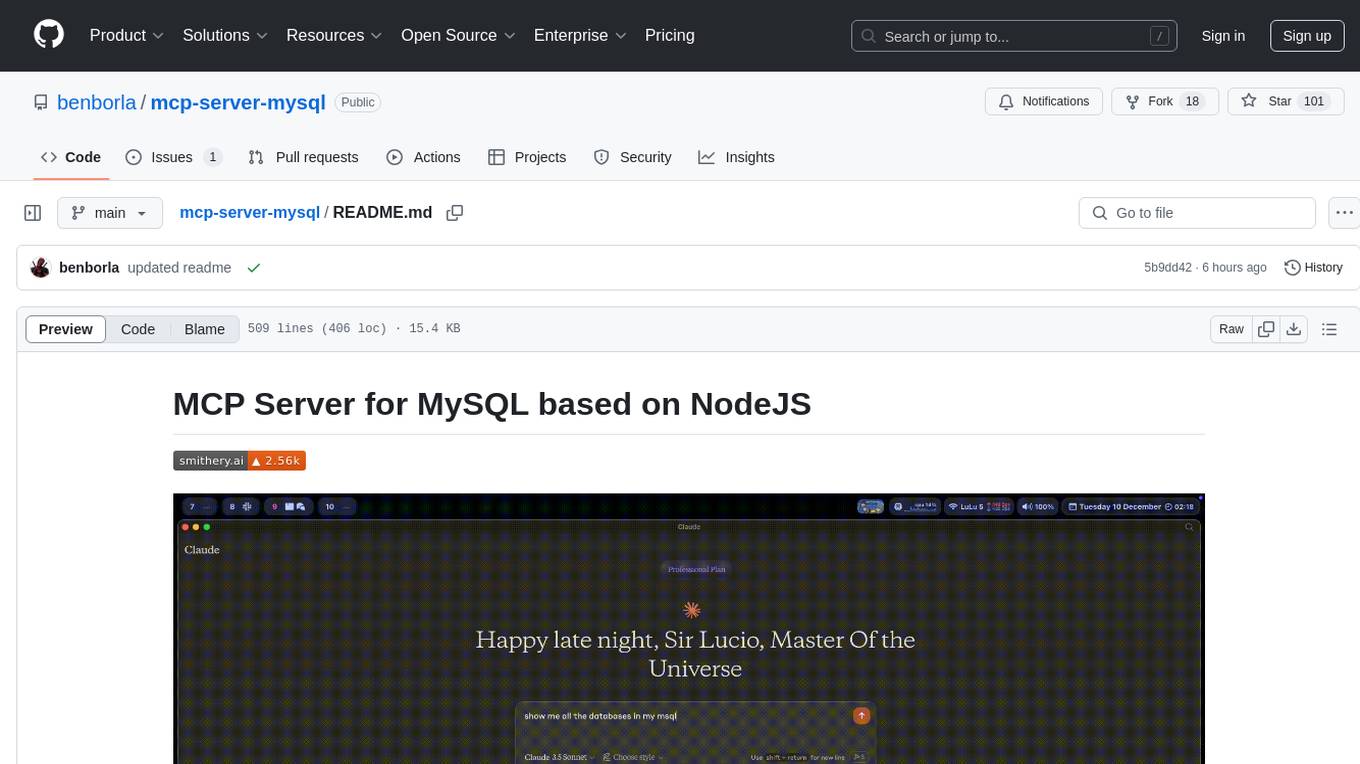
The MCP Server for MySQL based on NodeJS is a Model Context Protocol server that provides access to MySQL databases. It enables users to inspect database schemas and execute SQL queries. The server offers tools for executing SQL queries, providing comprehensive database information, security features like SQL injection prevention, performance optimizations, monitoring, and debugging capabilities. Users can configure the server using environment variables and advanced options. The server supports multi-DB mode, schema-specific permissions, and includes troubleshooting guidelines for common issues. Contributions are welcome, and the project roadmap includes enhancing query capabilities, security features, performance optimizations, monitoring, and expanding schema information.
README:
🚀 This is a modified version optimized for Claude Code with SSH tunnel support
Original Author: @benborla29
Original Repository: https://github.com/benborla/mcp-server-mysql
License: MIT
- ✅ Claude Code Integration - Optimized for use with Anthropic's Claude Code CLI
- ✅ SSH Tunnel Support - Built-in support for SSH tunnels to remote databases
- ✅ Auto-start/stop Hooks - Automatic tunnel management with Claude start/stop
- ✅ DDL Operations - Added
MYSQL_DISABLE_READ_ONLY_TRANSACTIONSfor CREATE TABLE support - ✅ Multi-Project Setup - Easy configuration for multiple projects with different databases
- Read the Setup Guide: See PROJECT_SETUP_GUIDE.md for detailed instructions
- Configure SSH Tunnels: Set up automatic SSH tunnels for remote databases
- Use with Claude: Integrated MCP server works seamlessly with Claude Code
A Model Context Protocol server that provides access to MySQL databases through SSH tunnels. This server enables Claude and other LLMs to inspect database schemas and execute SQL queries securely.
- Requirements
- Installation
- Components
- Configuration
- Environment Variables
- Multi-DB Mode
- Schema-Specific Permissions
- Testing
- Troubleshooting
- Contributing
- License
- Node.js v20 or higher
- MySQL 5.7 or higher (MySQL 8.0+ recommended)
- MySQL user with appropriate permissions for the operations you need
- For write operations: MySQL user with INSERT, UPDATE, and/or DELETE privileges
There are several ways to install and configure the MCP server but the most common would be checking this website https://smithery.ai/server/@benborla29/mcp-server-mysql
For Cursor IDE, you can install this MCP server with the following command in your project:
- Visit https://smithery.ai/server/@benborla29/mcp-server-mysql
- Follow the instruction for Cursor
MCP Get provides a centralized registry of MCP servers and simplifies the installation process.
If you already have this MCP server configured in Claude Desktop, you can import it automatically:
claude mcp add-from-claude-desktopThis will show an interactive dialog where you can select your mcp_server_mysql server to import with all existing configuration.
Using NPM/PNPM Global Installation:
First, install the package globally:
# Using npm
npm install -g @benborla29/mcp-server-mysql
# Using pnpm
pnpm add -g @benborla29/mcp-server-mysqlThen add the server to Claude Code:
claude mcp add mcp_server_mysql \
-e MYSQL_HOST="127.0.0.1" \
-e MYSQL_PORT="3306" \
-e MYSQL_USER="root" \
-e MYSQL_PASS="your_password" \
-e MYSQL_DB="your_database" \
-e ALLOW_INSERT_OPERATION="false" \
-e ALLOW_UPDATE_OPERATION="false" \
-e ALLOW_DELETE_OPERATION="false" \
-- npx @benborla29/mcp-server-mysqlUsing Local Repository (for development):
If you're running from a cloned repository:
claude mcp add mcp_server_mysql \
-e MYSQL_HOST="127.0.0.1" \
-e MYSQL_PORT="3306" \
-e MYSQL_USER="root" \
-e MYSQL_PASS="your_password" \
-e MYSQL_DB="your_database" \
-e ALLOW_INSERT_OPERATION="false" \
-e ALLOW_UPDATE_OPERATION="false" \
-e ALLOW_DELETE_OPERATION="false" \
-e PATH="/path/to/node/bin:/usr/bin:/bin" \
-e NODE_PATH="/path/to/node/lib/node_modules" \
-- /path/to/node /full/path/to/mcp-server-mysql/dist/index.jsReplace:
-
/path/to/nodewith your Node.js binary path (find withwhich node) -
/full/path/to/mcp-server-mysqlwith the full path to your cloned repository - Update MySQL credentials to match your environment
Using Unix Socket Connection:
For local MySQL instances using Unix sockets:
claude mcp add mcp_server_mysql \
-e MYSQL_SOCKET_PATH="/tmp/mysql.sock" \
-e MYSQL_USER="root" \
-e MYSQL_PASS="your_password" \
-e MYSQL_DB="your_database" \
-e ALLOW_INSERT_OPERATION="false" \
-e ALLOW_UPDATE_OPERATION="false" \
-e ALLOW_DELETE_OPERATION="false" \
-- npx @benborla29/mcp-server-mysqlConsider which scope to use based on your needs:
# Local scope (default) - only available in current project
claude mcp add mcp_server_mysql [options...]
# User scope - available across all your projects
claude mcp add mcp_server_mysql -s user [options...]
# Project scope - shared with team members via .mcp.json
claude mcp add mcp_server_mysql -s project [options...]For database servers with credentials, local or user scope is recommended to keep credentials private.
After adding the server, verify it's configured correctly:
# List all configured servers
claude mcp list
# Get details for your MySQL server
claude mcp get mcp_server_mysql
# Check server status within Claude Code
/mcpFor multi-database mode, omit the MYSQL_DB environment variable:
claude mcp add mcp_server_mysql_multi \
-e MYSQL_HOST="127.0.0.1" \
-e MYSQL_PORT="3306" \
-e MYSQL_USER="root" \
-e MYSQL_PASS="your_password" \
-e MULTI_DB_WRITE_MODE="false" \
-- npx @benborla29/mcp-server-mysqlFor advanced features, add additional environment variables:
claude mcp add mcp_server_mysql \
-e MYSQL_HOST="127.0.0.1" \
-e MYSQL_PORT="3306" \
-e MYSQL_USER="root" \
-e MYSQL_PASS="your_password" \
-e MYSQL_DB="your_database" \
-e MYSQL_POOL_SIZE="10" \
-e MYSQL_QUERY_TIMEOUT="30000" \
-e MYSQL_CACHE_TTL="60000" \
-e MYSQL_RATE_LIMIT="100" \
-e MYSQL_SSL="true" \
-e ALLOW_INSERT_OPERATION="false" \
-e ALLOW_UPDATE_OPERATION="false" \
-e ALLOW_DELETE_OPERATION="false" \
-e MYSQL_ENABLE_LOGGING="true" \
-- npx @benborla29/mcp-server-mysql-
Server Connection Issues: Use
/mcpcommand in Claude Code to check server status and authenticate if needed. -
Path Issues: If using a local repository, ensure Node.js paths are correctly set:
# Find your Node.js path which node # For PATH environment variable echo "$(which node)/../" # For NODE_PATH environment variable echo "$(which node)/../../lib/node_modules"
-
Permission Errors: Ensure your MySQL user has appropriate permissions for the operations you've enabled.
-
Server Not Starting: Check Claude Code logs or run the server directly to debug:
# Test the server directly npx @benborla29/mcp-server-mysql
For manual installation:
# Using npm
npm install -g @benborla29/mcp-server-mysql
# Using pnpm
pnpm add -g @benborla29/mcp-server-mysqlAfter manual installation, you'll need to configure your LLM application to use the MCP server (see Configuration section below).
If you want to clone and run this MCP server directly from the source code, follow these steps:
-
Clone the repository
git clone https://github.com/benborla/mcp-server-mysql.git cd mcp-server-mysql -
Install dependencies
npm install # or pnpm install -
Build the project
npm run build # or pnpm run build -
Configure Claude Desktop
Add the following to your Claude Desktop configuration file (
claude_desktop_config.json):{ "mcpServers": { "mcp_server_mysql": { "command": "/path/to/node", "args": [ "/full/path/to/mcp-server-mysql/dist/index.js" ], "env": { "MYSQL_HOST": "127.0.0.1", "MYSQL_PORT": "3306", "MYSQL_USER": "root", "MYSQL_PASS": "your_password", "MYSQL_DB": "your_database", "ALLOW_INSERT_OPERATION": "false", "ALLOW_UPDATE_OPERATION": "false", "ALLOW_DELETE_OPERATION": "false", "PATH": "/Users/atlasborla/Library/Application Support/Herd/config/nvm/versions/node/v22.9.0/bin:/usr/bin:/bin", // <--- Important to add the following, run in your terminal `echo "$(which node)/../"` to get the path "NODE_PATH": "/Users/atlasborla/Library/Application Support/Herd/config/nvm/versions/node/v22.9.0/lib/node_modules" // <--- Important to add the following, run in your terminal `echo "$(which node)/../../lib/node_modules"` } } } }Replace:
-
/path/to/nodewith the full path to your Node.js binary (find it withwhich node) -
/full/path/to/mcp-server-mysqlwith the full path to where you cloned the repository - Set the MySQL credentials to match your environment
-
-
Test the server
# Run the server directly to test node dist/index.jsIf it connects to MySQL successfully, you're ready to use it with Claude Desktop.
To run in remote mode, you'll need to provide environment variables to the npx script.
-
Create env file in preferred directory
# create .env file touch .env -
Copy-paste example file from this repository
-
Set the MySQL credentials to match your environment
-
Set
IS_REMOTE_MCP=true -
Set
REMOTE_SECRET_KEYto a secure string. -
Provide custom
PORTif needed. Default is 3000. -
Load variables in current session:
source .env -
Run the server
npx @benborla29/mcp-server-mysql
-
Configure your agent to connect to the MCP with the next configuration:
{ "mcpServers": { "mysql": { "url": "http://your-host:3000/mcp", "type": "streamableHttp", "headers": { "Authorization": "Bearer <REMOTE_SECRET_KEY>" } } } }
-
mysql_query
- Execute SQL queries against the connected database
- Input:
sql(string): The SQL query to execute - By default, limited to READ ONLY operations
- Optional write operations (when enabled via configuration):
- INSERT: Add new data to tables (requires
ALLOW_INSERT_OPERATION=true) - UPDATE: Modify existing data (requires
ALLOW_UPDATE_OPERATION=true) - DELETE: Remove data (requires
ALLOW_DELETE_OPERATION=true)
- INSERT: Add new data to tables (requires
- All operations are executed within a transaction with proper commit/rollback handling
- Supports prepared statements for secure parameter handling
- Configurable query timeouts and result pagination
- Built-in query execution statistics
The server provides comprehensive database information:
-
Table Schemas
- JSON schema information for each table
- Column names and data types
- Index information and constraints
- Foreign key relationships
- Table statistics and metrics
- Automatically discovered from database metadata
- SQL injection prevention through prepared statements
- Query whitelisting/blacklisting capabilities
- Rate limiting for query execution
- Query complexity analysis
- Configurable connection encryption
- Read-only transaction enforcement
- Optimized connection pooling
- Query result caching
- Large result set streaming
- Query execution plan analysis
- Configurable query timeouts
- Comprehensive query logging
- Performance metrics collection
- Error tracking and reporting
- Health check endpoints
- Query execution statistics
If you installed using Smithery, your configuration is already set up. You can view or modify it with:
smithery configure @benborla29/mcp-server-mysqlWhen reconfiguring, you can update any of the MySQL connection details as well as the write operation settings:
-
Basic connection settings:
- MySQL Host, Port, User, Password, Database
- SSL/TLS configuration (if your database requires secure connections)
-
Write operation permissions:
- Allow INSERT Operations: Set to true if you want to allow adding new data
- Allow UPDATE Operations: Set to true if you want to allow updating existing data
- Allow DELETE Operations: Set to true if you want to allow deleting data
For security reasons, all write operations are disabled by default. Only enable these settings if you specifically need Claude to modify your database data.
For more control over the MCP server's behavior, you can use these advanced configuration options:
{
"mcpServers": {
"mcp_server_mysql": {
"command": "/path/to/npx/binary/npx",
"args": [
"-y",
"@benborla29/mcp-server-mysql"
],
"env": {
// Basic connection settings
"MYSQL_HOST": "127.0.0.1",
"MYSQL_PORT": "3306",
"MYSQL_USER": "root",
"MYSQL_PASS": "",
"MYSQL_DB": "db_name",
"PATH": "/path/to/node/bin:/usr/bin:/bin",
// Performance settings
"MYSQL_POOL_SIZE": "10",
"MYSQL_QUERY_TIMEOUT": "30000",
"MYSQL_CACHE_TTL": "60000",
// Security settings
"MYSQL_RATE_LIMIT": "100",
"MYSQL_MAX_QUERY_COMPLEXITY": "1000",
"MYSQL_SSL": "true",
// Monitoring settings
"ENABLE_LOGGING": "true",
"MYSQL_LOG_LEVEL": "info",
"MYSQL_METRICS_ENABLED": "true",
// Write operation flags
"ALLOW_INSERT_OPERATION": "false",
"ALLOW_UPDATE_OPERATION": "false",
"ALLOW_DELETE_OPERATION": "false"
}
}
}
}-
MYSQL_SOCKET_PATH: Unix socket path for local connections (e.g., "/tmp/mysql.sock") -
MYSQL_HOST: MySQL server host (default: "127.0.0.1") - ignored if MYSQL_SOCKET_PATH is set -
MYSQL_PORT: MySQL server port (default: "3306") - ignored if MYSQL_SOCKET_PATH is set -
MYSQL_USER: MySQL username (default: "root") -
MYSQL_PASS: MySQL password -
MYSQL_DB: Target database name (leave empty for multi-DB mode)
-
MYSQL_POOL_SIZE: Connection pool size (default: "10") -
MYSQL_QUERY_TIMEOUT: Query timeout in milliseconds (default: "30000") -
MYSQL_CACHE_TTL: Cache time-to-live in milliseconds (default: "60000")
-
MYSQL_RATE_LIMIT: Maximum queries per minute (default: "100") -
MYSQL_MAX_QUERY_COMPLEXITY: Maximum query complexity score (default: "1000") -
MYSQL_SSL: Enable SSL/TLS encryption (default: "false") -
ALLOW_INSERT_OPERATION: Enable INSERT operations (default: "false") -
ALLOW_UPDATE_OPERATION: Enable UPDATE operations (default: "false") -
ALLOW_DELETE_OPERATION: Enable DELETE operations (default: "false") -
ALLOW_DDL_OPERATION: Enable DDL operations (default: "false") -
MYSQL_DISABLE_READ_ONLY_TRANSACTIONS: [NEW] Disable read-only transaction enforcement (default: "false")⚠️ Security Warning: Only enable this if you need full write capabilities and trust the LLM with your database -
SCHEMA_INSERT_PERMISSIONS: Schema-specific INSERT permissions -
SCHEMA_UPDATE_PERMISSIONS: Schema-specific UPDATE permissions -
SCHEMA_DELETE_PERMISSIONS: Schema-specific DELETE permissions -
SCHEMA_DDL_PERMISSIONS: Schema-specific DDL permissions -
MULTI_DB_WRITE_MODE: Enable write operations in multi-DB mode (default: "false")
-
MYSQL_ENABLE_LOGGING: Enable query logging (default: "false") -
MYSQL_LOG_LEVEL: Logging level (default: "info") -
MYSQL_METRICS_ENABLED: Enable performance metrics (default: "false")
-
IS_REMOTE_MCP: Enable remote MCP mode (default: "false") -
REMOTE_SECRET_KEY: Secret key for remote MCP authentication (default: ""). If not provided, remote MCP mode will be disabled. -
PORT: Port number for the remote MCP server (default: 3000)
MCP-Server-MySQL supports connecting to multiple databases when no specific database is set. This allows the LLM to query any database the MySQL user has access to. For full details, see README-MULTI-DB.md.
To enable multi-DB mode, simply leave the MYSQL_DB environment variable empty. In multi-DB mode, queries require schema qualification:
-- Use fully qualified table names
SELECT * FROM database_name.table_name;
-- Or use USE statements to switch between databases
USE database_name;
SELECT * FROM table_name;For fine-grained control over database operations, MCP-Server-MySQL now supports schema-specific permissions. This allows different databases to have different levels of access (read-only, read-write, etc.).
SCHEMA_INSERT_PERMISSIONS=development:true,test:true,production:false
SCHEMA_UPDATE_PERMISSIONS=development:true,test:true,production:false
SCHEMA_DELETE_PERMISSIONS=development:false,test:true,production:false
SCHEMA_DDL_PERMISSIONS=development:false,test:true,production:falseFor complete details and security recommendations, see README-MULTI-DB.md.
Before running tests, you need to set up the test database and seed it with test data:
-
Create Test Database and User
-- Connect as root and create test database CREATE DATABASE IF NOT EXISTS mcp_test; -- Create test user with appropriate permissions CREATE USER IF NOT EXISTS 'mcp_test'@'localhost' IDENTIFIED BY 'mcp_test_password'; GRANT ALL PRIVILEGES ON mcp_test.* TO 'mcp_test'@'localhost'; FLUSH PRIVILEGES;
-
Run Database Setup Script
# Run the database setup script pnpm run setup:test:dbThis will create the necessary tables and seed data. The script is located in
scripts/setup-test-db.ts -
Configure Test Environment Create a
.env.testfile in the project root (if not existing):MYSQL_HOST=127.0.0.1 MYSQL_PORT=3306 MYSQL_USER=mcp_test MYSQL_PASS=mcp_test_password MYSQL_DB=mcp_test
-
Update package.json Scripts Add these scripts to your package.json:
{ "scripts": { "setup:test:db": "ts-node scripts/setup-test-db.ts", "pretest": "pnpm run setup:test:db", "test": "vitest run", "test:watch": "vitest", "test:coverage": "vitest run --coverage" } }
The project includes a comprehensive test suite to ensure functionality and reliability:
# First-time setup
pnpm run setup:test:db
# Run all tests
pnpm testThe evals package loads an mcp client that then runs the index.ts file, so there is no need to rebuild between tests. You can load environment variables by prefixing the npx command. Full documentation can be found at MCP Evals.
OPENAI_API_KEY=your-key npx mcp-eval evals.ts index.ts-
Connection Issues
- Verify MySQL server is running and accessible
- Check credentials and permissions
- Ensure SSL/TLS configuration is correct if enabled
- Try connecting with a MySQL client to confirm access
-
Performance Issues
- Adjust connection pool size
- Configure query timeout values
- Enable query caching if needed
- Check query complexity settings
- Monitor server resource usage
-
Security Restrictions
- Review rate limiting configuration
- Check query whitelist/blacklist settings
- Verify SSL/TLS settings
- Ensure the user has appropriate MySQL permissions
-
Path Resolution If you encounter an error "Could not connect to MCP server mcp-server-mysql", explicitly set the path of all required binaries:
{ "env": { "PATH": "/path/to/node/bin:/usr/bin:/bin" } }Where can I find my
nodebin path Run the following command to get it:For PATH
echo "$(which node)/../"
For NODE_PATH
echo "$(which node)/../../lib/node_modules"
-
Claude Desktop Specific Issues
-
If you see "Server disconnected" logs in Claude Desktop, check the logs at
~/Library/Logs/Claude/mcp-server-mcp_server_mysql.log -
Ensure you're using the absolute path to both the Node binary and the server script
-
Check if your
.envfile is being properly loaded; use explicit environment variables in the configuration -
Try running the server directly from the command line to see if there are connection issues
-
If you need write operations (INSERT, UPDATE, DELETE), set the appropriate flags to "true" in your configuration:
"env": { "ALLOW_INSERT_OPERATION": "true", // Enable INSERT operations "ALLOW_UPDATE_OPERATION": "true", // Enable UPDATE operations "ALLOW_DELETE_OPERATION": "true" // Enable DELETE operations }
-
Ensure your MySQL user has the appropriate permissions for the operations you're enabling
-
For direct execution configuration, use:
{ "mcpServers": { "mcp_server_mysql": { "command": "/full/path/to/node", "args": [ "/full/path/to/mcp-server-mysql/dist/index.js" ], "env": { "MYSQL_HOST": "127.0.0.1", "MYSQL_PORT": "3306", "MYSQL_USER": "root", "MYSQL_PASS": "your_password", "MYSQL_DB": "your_database" } } } }
-
-
Authentication Issues
-
For MySQL 8.0+, ensure the server supports the
caching_sha2_passwordauthentication plugin -
Check if your MySQL user is configured with the correct authentication method
-
Try creating a user with legacy authentication if needed:
CREATE USER 'user'@'localhost' IDENTIFIED WITH mysql_native_password BY 'password';
@lizhuangs
-
-
I am encountering
Error [ERR_MODULE_NOT_FOUND]: Cannot find package 'dotenv' imported fromerror try this workaround:npx -y -p @benborla29/mcp-server-mysql -p dotenv mcp-server-mysql
Thanks to @lizhuangs
Contributions are welcome! Please feel free to submit a Pull Request to https://github.com/benborla/mcp-server-mysql
- Clone the repository
- Install dependencies:
pnpm install - Build the project:
pnpm run build - Run tests:
pnpm test
We're actively working on enhancing this MCP server. Check our CHANGELOG.md for details on planned features, including:
- Enhanced query capabilities with prepared statements
- Advanced security features
- Performance optimizations
- Comprehensive monitoring
- Expanded schema information
If you'd like to contribute to any of these areas, please check the issues on GitHub or open a new one to discuss your ideas.
- Fork the repository
- Create a feature branch:
git checkout -b feature/your-feature-name - Commit your changes:
git commit -am 'Add some feature' - Push to the branch:
git push origin feature/your-feature-name - Submit a pull request
This MCP server is licensed under the MIT License. See the LICENSE file for details.
For Tasks:
Click tags to check more tools for each tasksFor Jobs:
Alternative AI tools for mcp-server-mysql
Similar Open Source Tools

mcp-server-mysql
The MCP Server for MySQL based on NodeJS is a Model Context Protocol server that provides access to MySQL databases. It enables users to inspect database schemas and execute SQL queries. The server offers tools for executing SQL queries, providing comprehensive database information, security features like SQL injection prevention, performance optimizations, monitoring, and debugging capabilities. Users can configure the server using environment variables and advanced options. The server supports multi-DB mode, schema-specific permissions, and includes troubleshooting guidelines for common issues. Contributions are welcome, and the project roadmap includes enhancing query capabilities, security features, performance optimizations, monitoring, and expanding schema information.
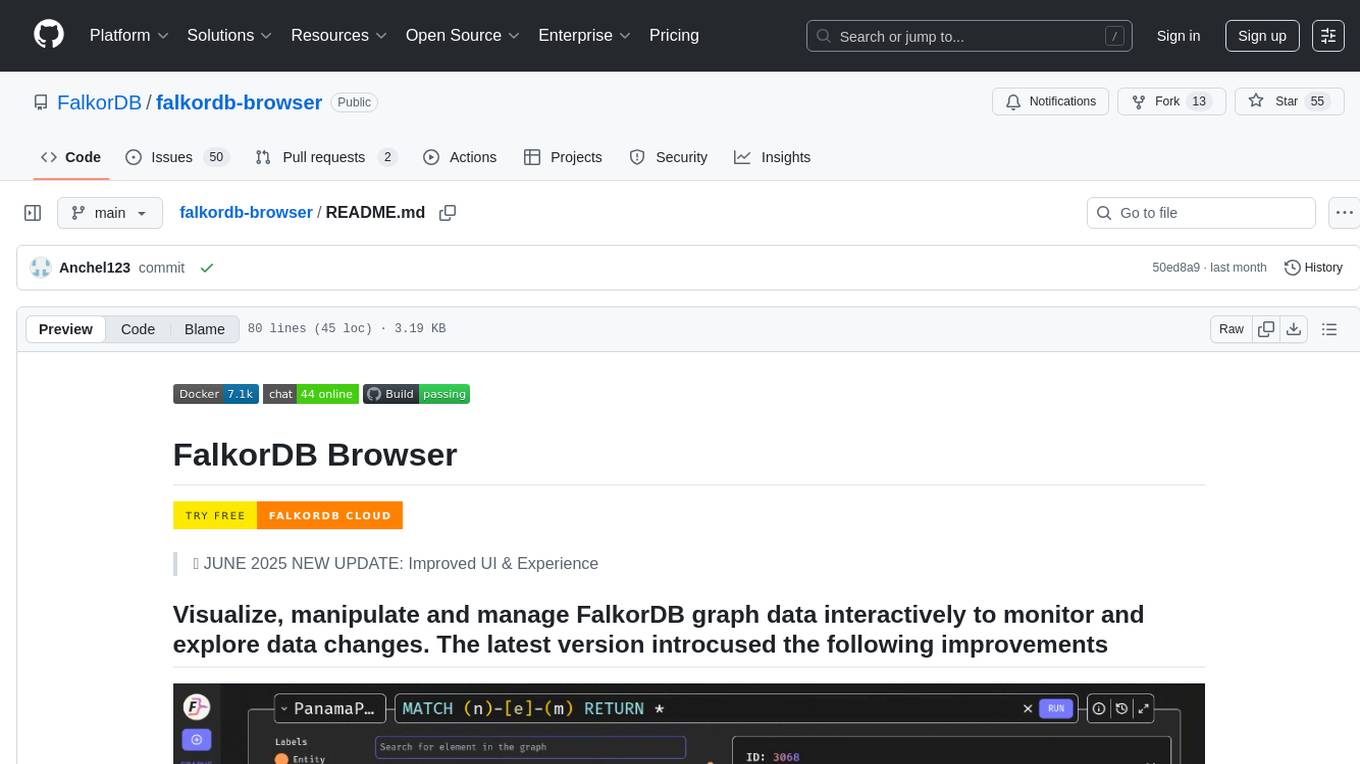
falkordb-browser
FalkorDB Browser is a user-friendly web application for browsing and managing databases. It provides an intuitive interface for users to interact with their databases, allowing them to view, edit, and query data easily. With FalkorDB Browser, users can perform various database operations without the need for complex commands or scripts, making database management more accessible and efficient.

SQLBot
SQLBot is a versatile tool for executing SQL queries and managing databases. It provides a user-friendly interface for interacting with databases, allowing users to easily query, insert, update, and delete data. SQLBot supports various database systems such as MySQL, PostgreSQL, and SQLite, making it a valuable tool for developers, data analysts, and database administrators. With SQLBot, users can streamline their database management tasks and improve their productivity by quickly accessing and manipulating data without the need for complex SQL commands.
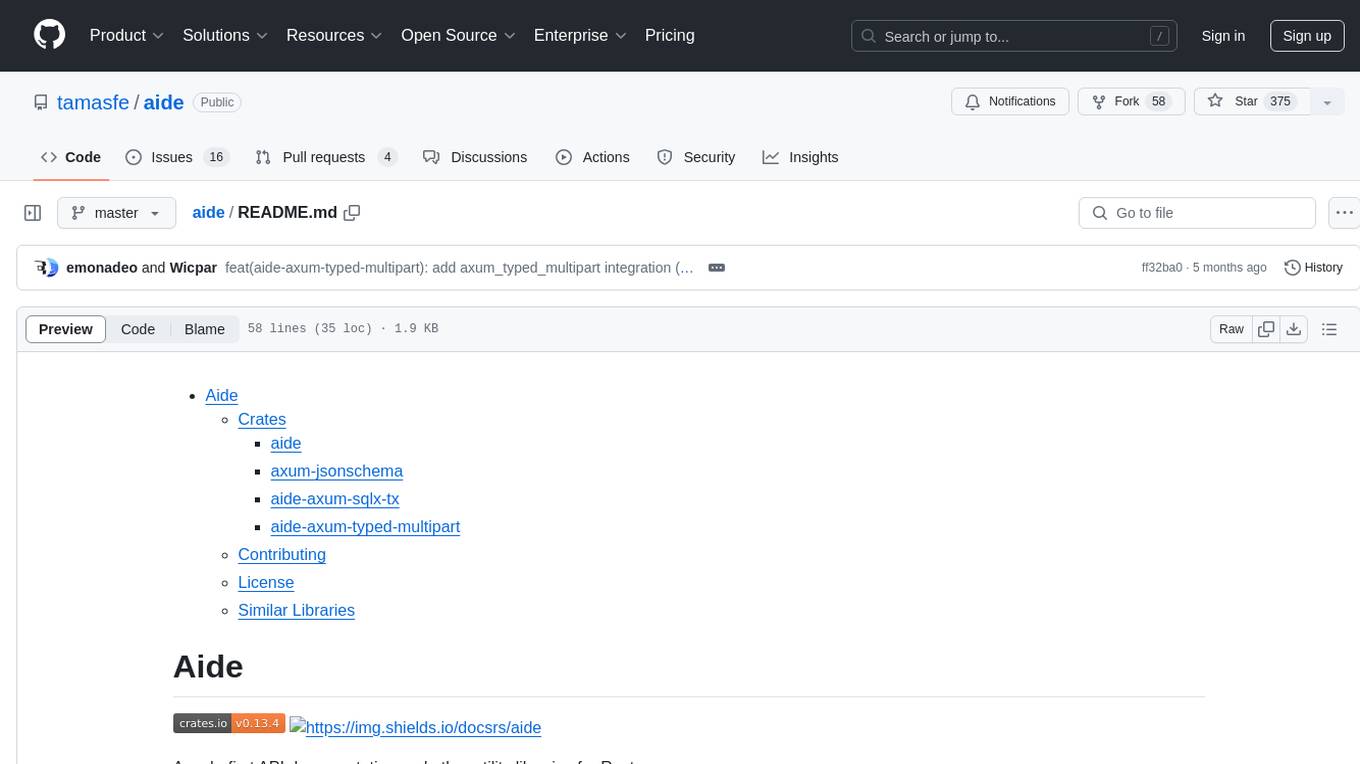
aide
Aide is a code-first API documentation and utility library for Rust, along with other related utility crates for web-servers. It provides tools for creating API documentation and handling JSON request validation. The repository contains multiple crates that offer drop-in replacements for existing libraries, ensuring compatibility with Aide. Contributions are welcome, and the code is dual licensed under MIT and Apache-2.0. If Aide does not meet your requirements, you can explore similar libraries like paperclip, utoipa, and okapi.
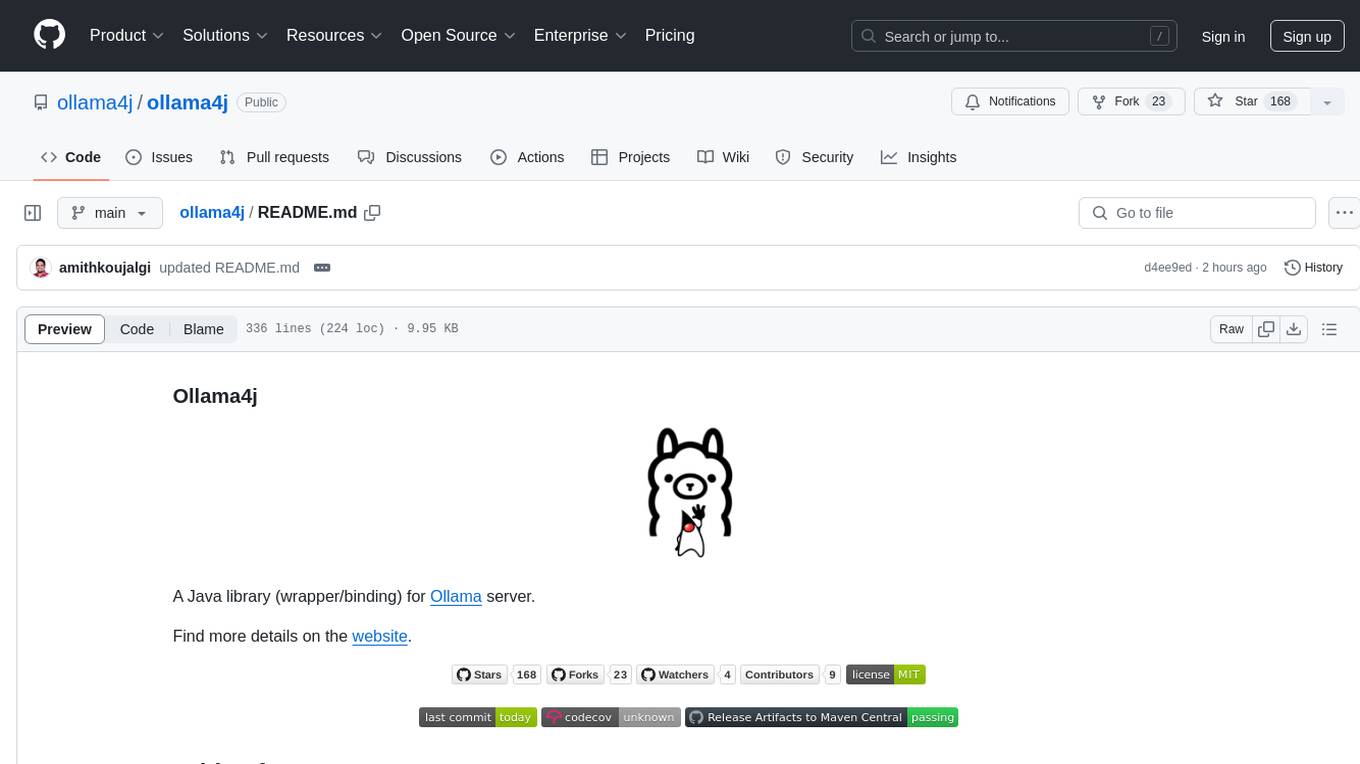
ollama4j
Ollama4j is a Java library that serves as a wrapper or binding for the Ollama server. It allows users to communicate with the Ollama server and manage models for various deployment scenarios. The library provides APIs for interacting with Ollama, generating fake data, testing UI interactions, translating messages, and building web UIs. Users can easily integrate Ollama4j into their Java projects to leverage the functionalities offered by the Ollama server.

MCP-PostgreSQL-Ops
MCP-PostgreSQL-Ops is a repository containing scripts and tools for managing and optimizing PostgreSQL databases. It provides a set of utilities to automate common database administration tasks, such as backup and restore, performance tuning, and monitoring. The scripts are designed to simplify the operational aspects of running PostgreSQL databases, making it easier for administrators to maintain and optimize their database instances. With MCP-PostgreSQL-Ops, users can streamline their database management processes and improve the overall performance and reliability of their PostgreSQL deployments.
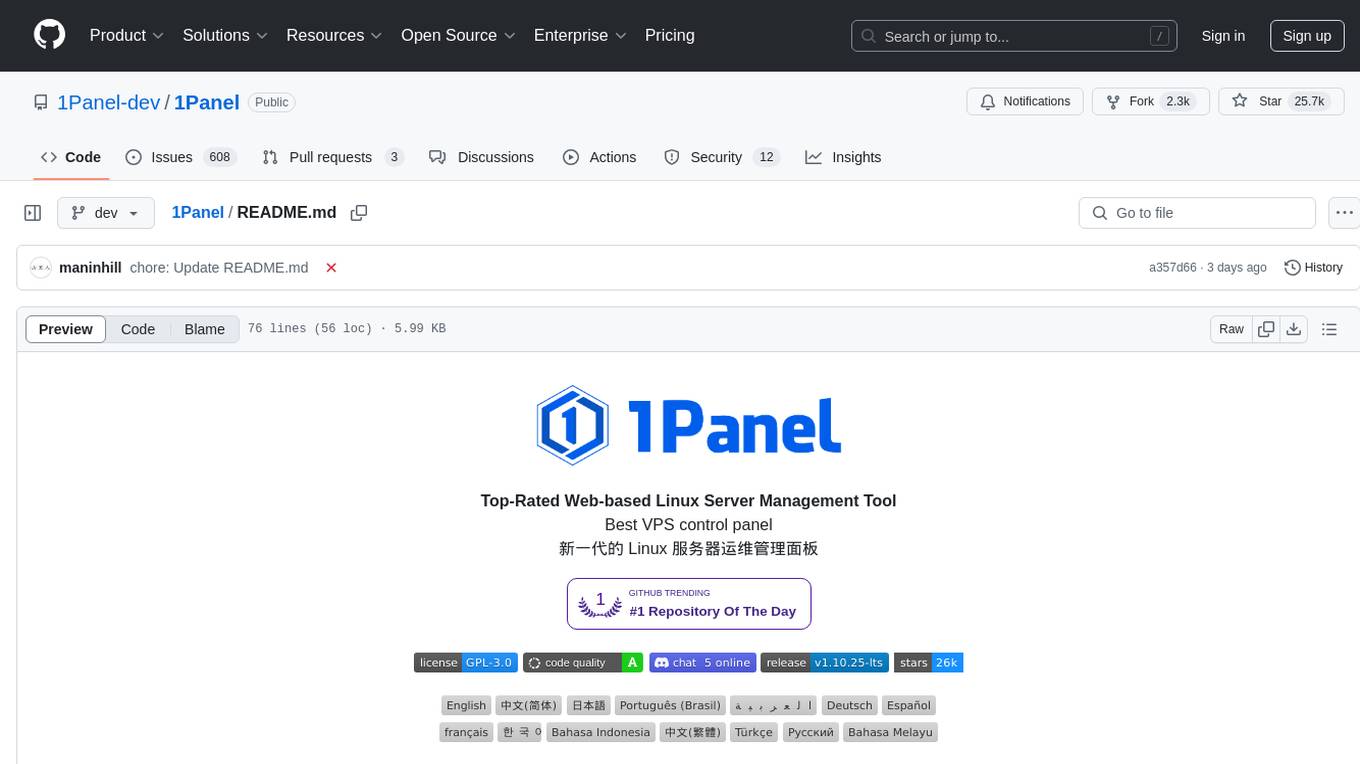
1Panel
1Panel is an open-source, modern web-based control panel for Linux server management. It provides efficient management through a user-friendly web graphical interface, enabling users to effortlessly manage their Linux servers. Key features include host monitoring, file management, database administration, container management, rapid website deployment with WordPress integration, an application store for easy installation and updates, security and reliability through containerization and secure application deployment practices, integrated firewall management, log auditing capabilities, and one-click backup & restore functionality supporting various cloud storage solutions.
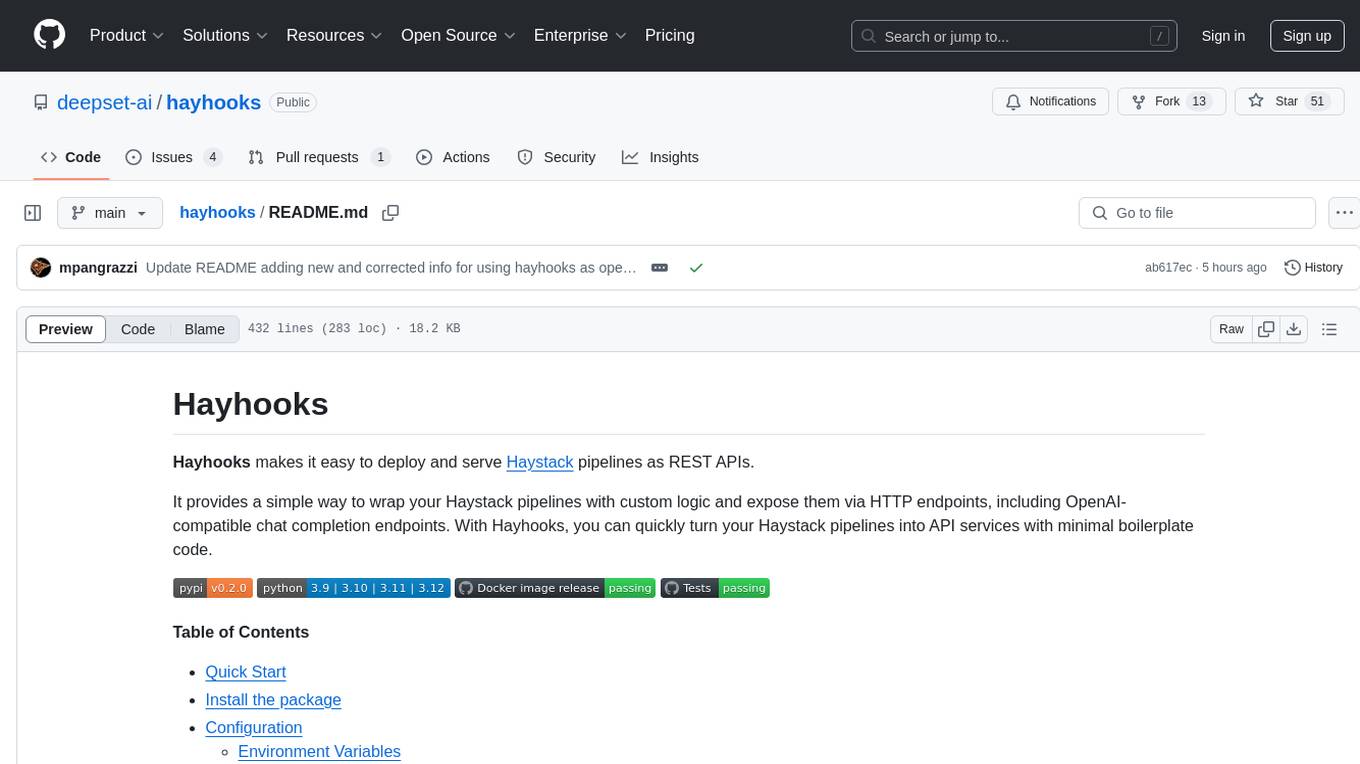
hayhooks
Hayhooks is a tool that simplifies the deployment and serving of Haystack pipelines as REST APIs. It allows users to wrap their pipelines with custom logic and expose them via HTTP endpoints, including OpenAI-compatible chat completion endpoints. With Hayhooks, users can easily convert their Haystack pipelines into API services with minimal boilerplate code.
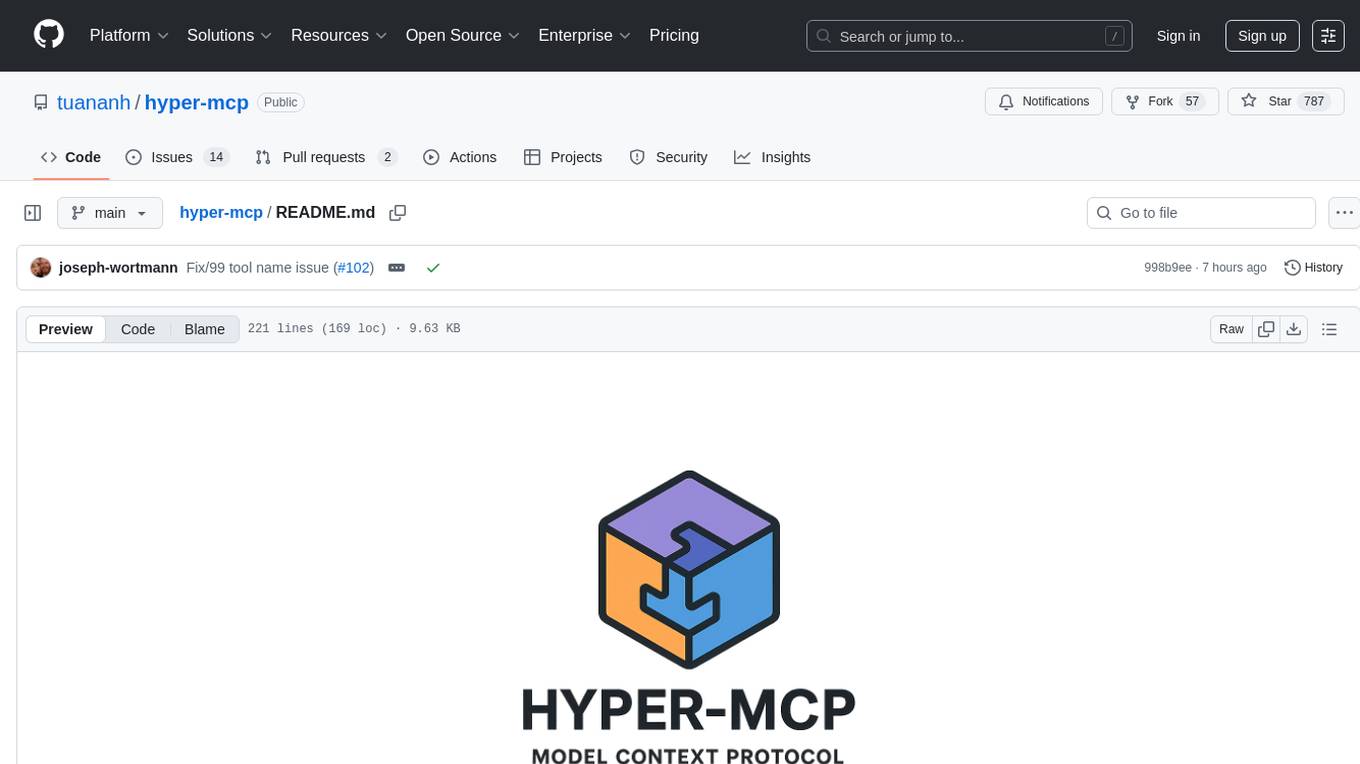
hyper-mcp
hyper-mcp is a fast and secure MCP server that enables adding AI capabilities to applications through WebAssembly plugins. It supports writing plugins in various languages, distributing them via standard OCI registries, and running them in resource-constrained environments. The tool offers sandboxing with WASM for limiting access, cross-platform compatibility, and deployment flexibility. Security features include sandboxed plugins, memory-safe execution, secure plugin distribution, and fine-grained access control. Users can configure the tool for global or project-specific use, start the server with different transport options, and utilize available plugins for tasks like time calculations, QR code generation, hash generation, IP retrieval, and webpage fetching.
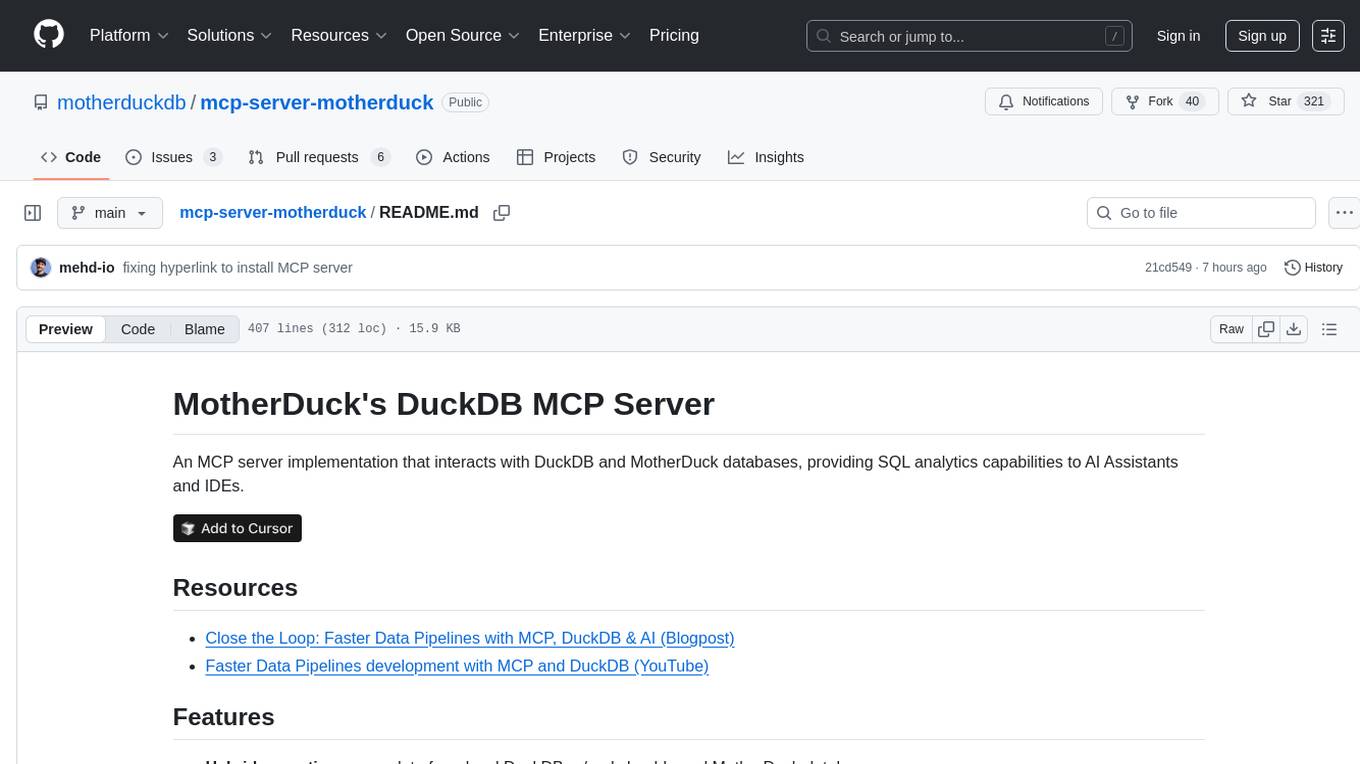
mcp-server-motherduck
The mcp-server-motherduck repository is a server-side application that provides a centralized platform for managing and monitoring multiple Minecraft servers. It allows server administrators to easily control various aspects of their Minecraft servers, such as player management, world backups, and server performance monitoring. The application is designed to streamline server management tasks and enhance the overall gaming experience for both server administrators and players.

fastapi_mcp
FastAPI-MCP is a zero-configuration tool that automatically exposes FastAPI endpoints as Model Context Protocol (MCP) tools. It allows for direct integration with FastAPI apps, automatic discovery and conversion of endpoints to MCP tools, preservation of request and response schemas, documentation preservation similar to Swagger, and the ability to extend with custom MCP tools. Users can easily add an MCP server to their FastAPI application and customize the server creation and configuration. The tool supports connecting to the MCP server using SSE or mcp-proxy stdio for different MCP clients. FastAPI-MCP is developed and maintained by Tadata Inc.
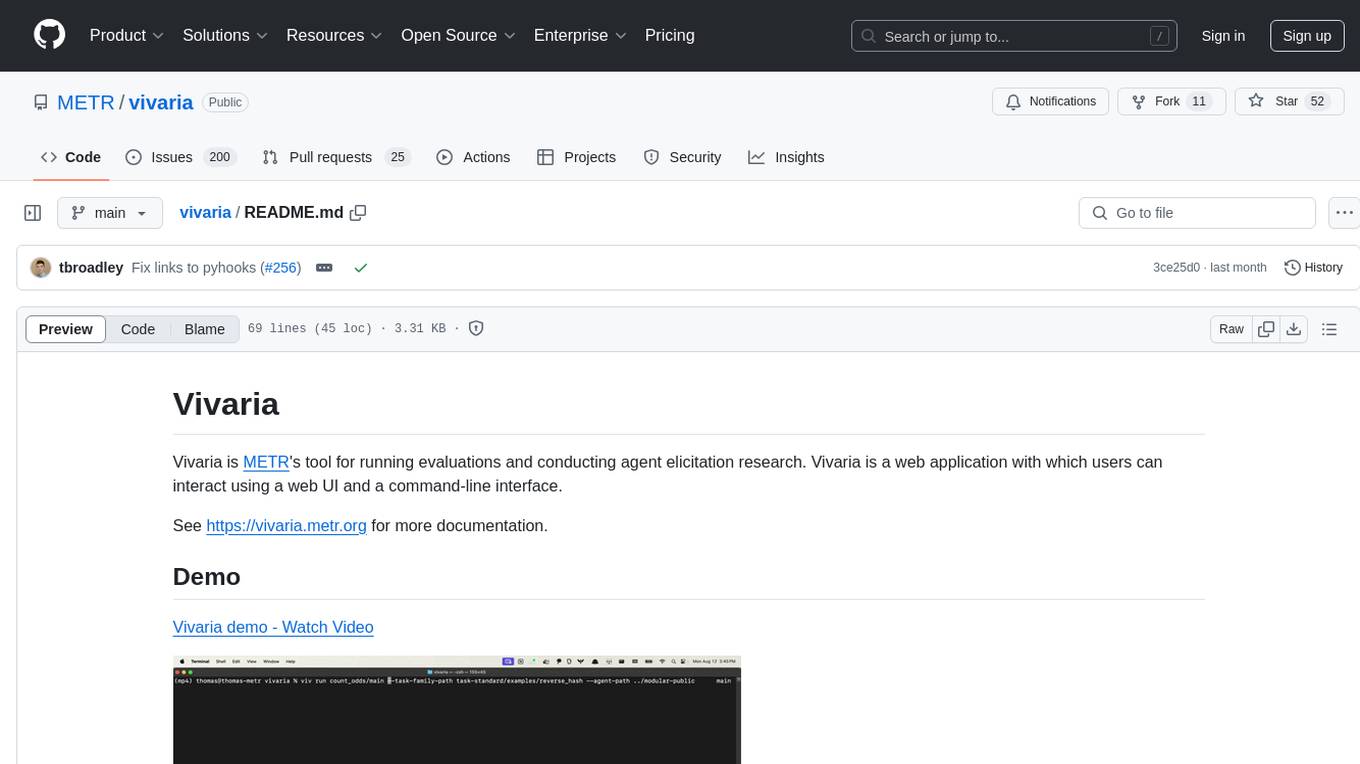
vivaria
Vivaria is a web application tool designed for running evaluations and conducting agent elicitation research. Users can interact with Vivaria using a web UI and a command-line interface. It allows users to start task environments based on METR Task Standard definitions, run AI agents, perform agent elicitation research, view API requests and responses, add tags and comments to runs, store results in a PostgreSQL database, sync data to Airtable, test prompts against LLMs, and authenticate using Auth0.
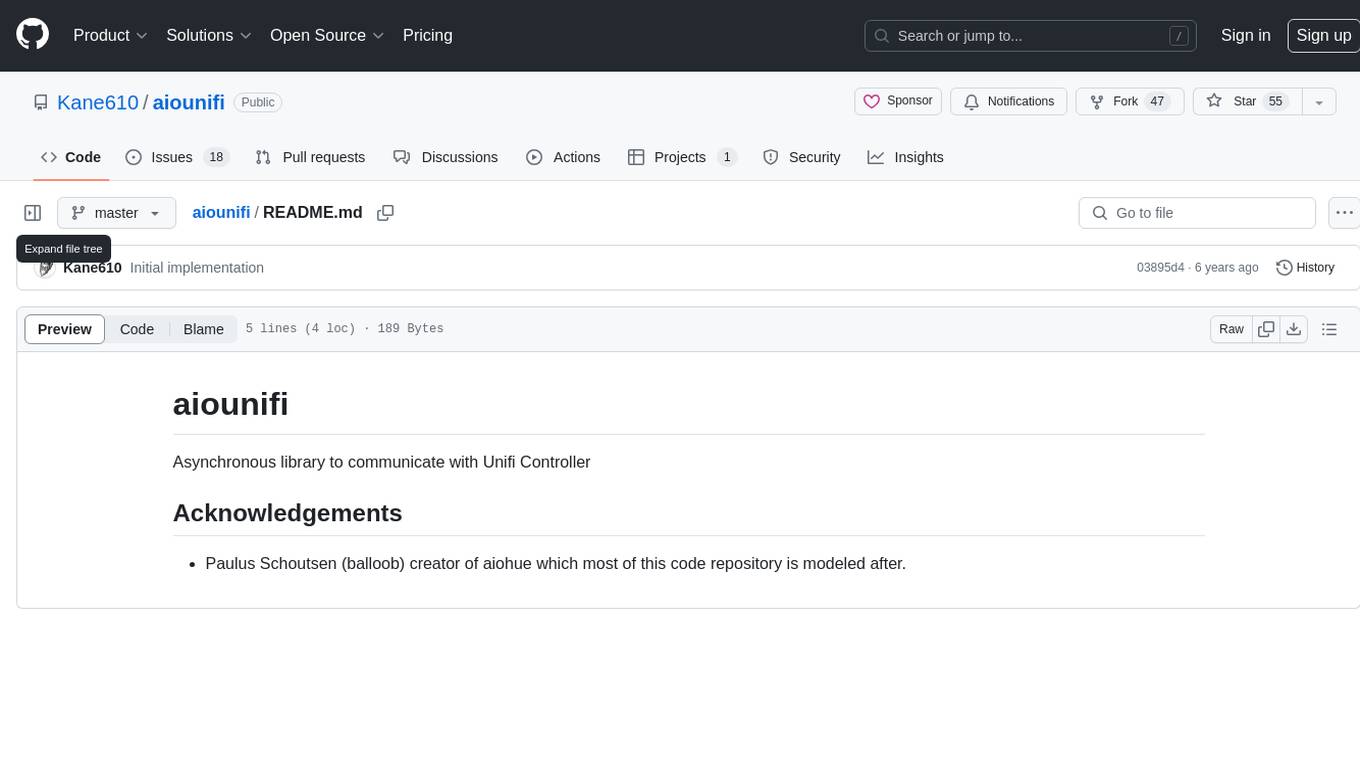
aiounifi
Aiounifi is a Python library that provides a simple interface for interacting with the Unifi Controller API. It allows users to easily manage their Unifi network devices, such as access points, switches, and gateways, through automated scripts or applications. With Aiounifi, users can retrieve device information, perform configuration changes, monitor network performance, and more, all through a convenient and efficient API wrapper. This library simplifies the process of integrating Unifi network management into custom solutions, making it ideal for network administrators, developers, and enthusiasts looking to automate and streamline their network operations.
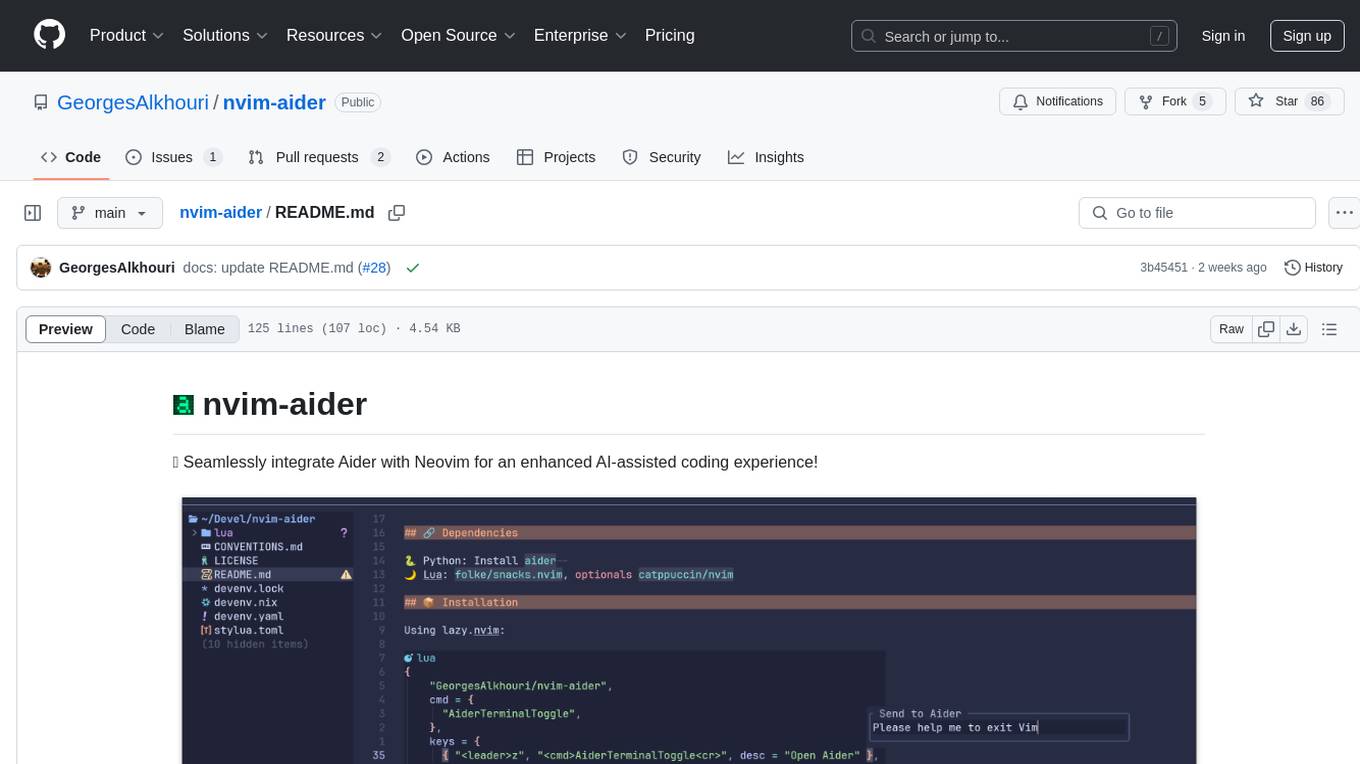
nvim-aider
Nvim-aider is a plugin for Neovim that provides additional functionality and key mappings to enhance the user's editing experience. It offers features such as code navigation, quick access to commonly used commands, and improved text manipulation tools. With Nvim-aider, users can streamline their workflow and increase productivity while working with Neovim.

ai21-python
The AI21 Labs Python SDK is a comprehensive tool for interacting with the AI21 API. It provides functionalities for chat completions, conversational RAG, token counting, error handling, and support for various cloud providers like AWS, Azure, and Vertex. The SDK offers both synchronous and asynchronous usage, along with detailed examples and documentation. Users can quickly get started with the SDK to leverage AI21's powerful models for various natural language processing tasks.
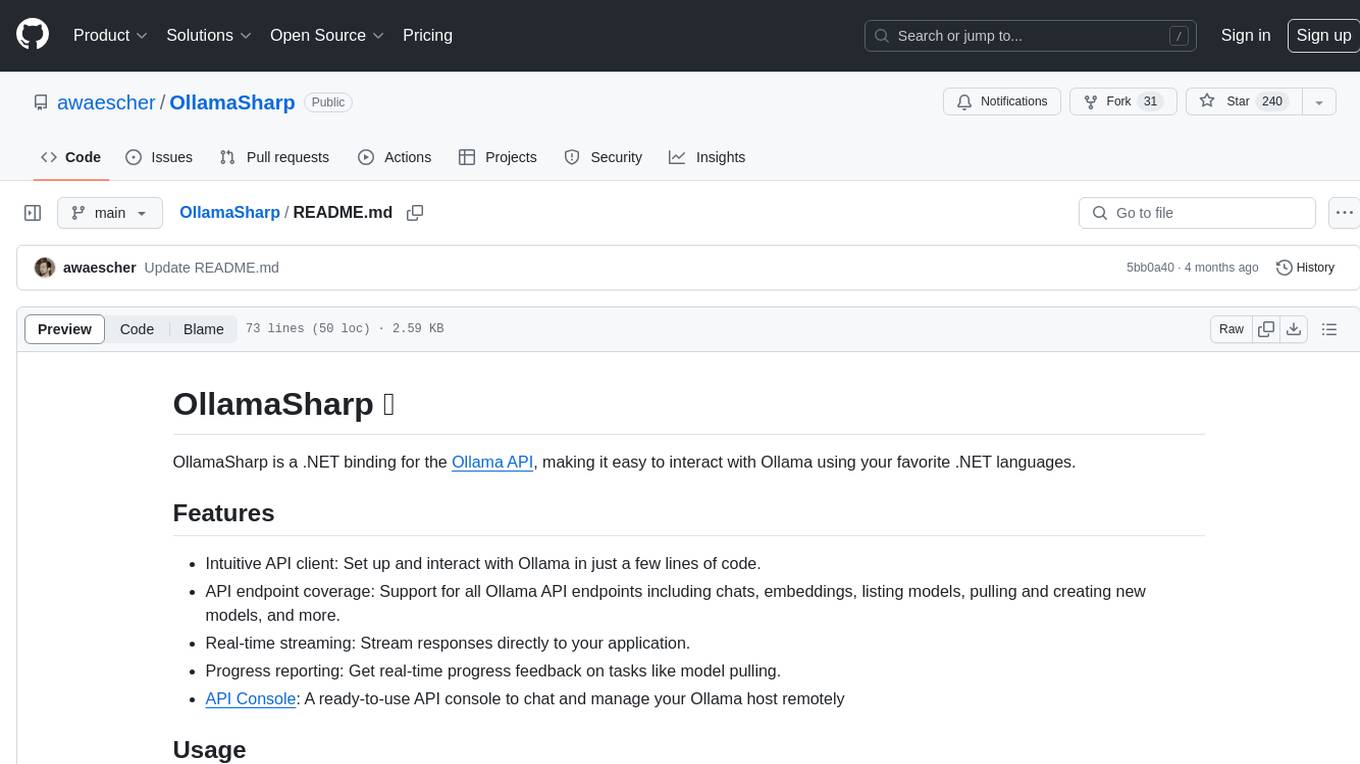
OllamaSharp
OllamaSharp is a .NET binding for the Ollama API, providing an intuitive API client to interact with Ollama. It offers support for all Ollama API endpoints, real-time streaming, progress reporting, and an API console for remote management. Users can easily set up the client, list models, pull models with progress feedback, stream completions, and build interactive chats. The project includes a demo console for exploring and managing the Ollama host.
For similar tasks

mcp-server-mysql
The MCP Server for MySQL based on NodeJS is a Model Context Protocol server that provides access to MySQL databases. It enables users to inspect database schemas and execute SQL queries. The server offers tools for executing SQL queries, providing comprehensive database information, security features like SQL injection prevention, performance optimizations, monitoring, and debugging capabilities. Users can configure the server using environment variables and advanced options. The server supports multi-DB mode, schema-specific permissions, and includes troubleshooting guidelines for common issues. Contributions are welcome, and the project roadmap includes enhancing query capabilities, security features, performance optimizations, monitoring, and expanding schema information.
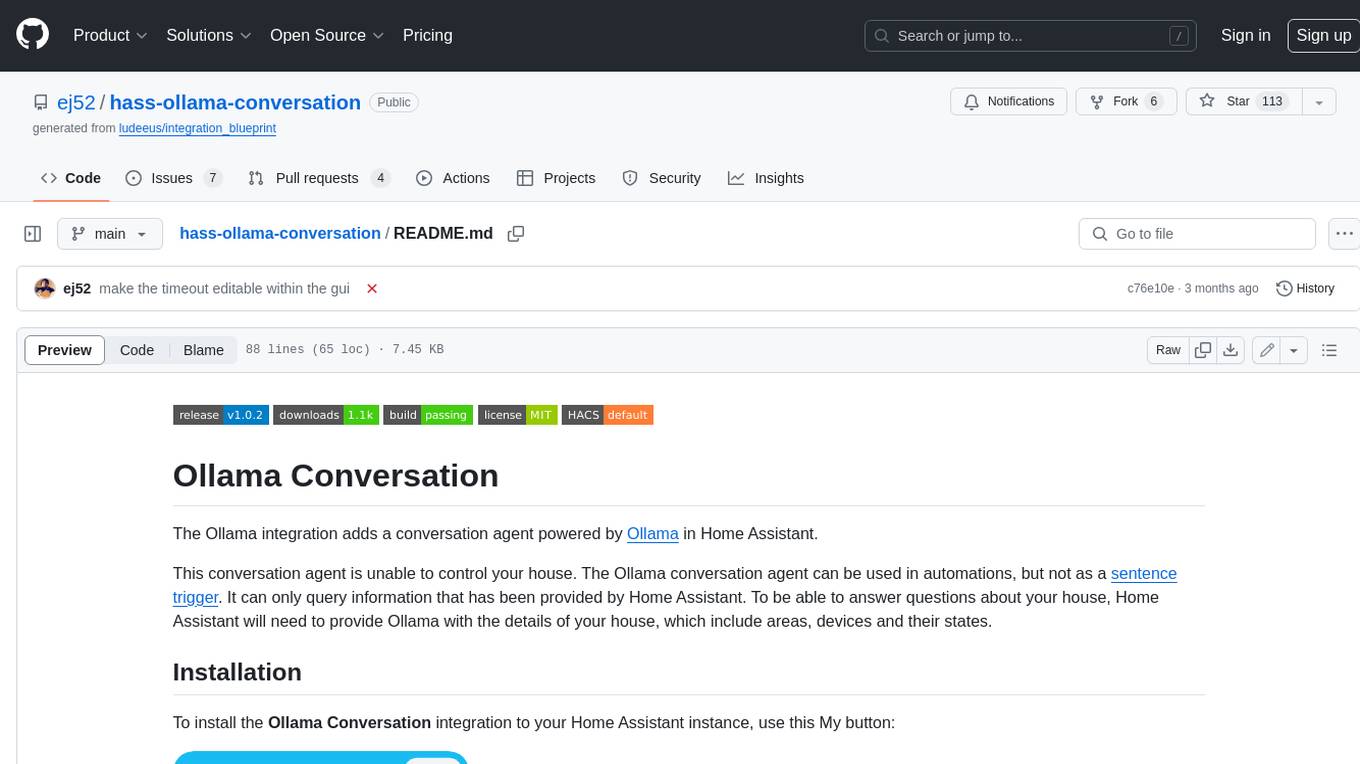
hass-ollama-conversation
The Ollama Conversation integration adds a conversation agent powered by Ollama in Home Assistant. This agent can be used in automations to query information provided by Home Assistant about your house, including areas, devices, and their states. Users can install the integration via HACS and configure settings such as API timeout, model selection, context size, maximum tokens, and other parameters to fine-tune the responses generated by the AI language model. Contributions to the project are welcome, and discussions can be held on the Home Assistant Community platform.

rclip
rclip is a command-line photo search tool powered by the OpenAI's CLIP neural network. It allows users to search for images using text queries, similar image search, and combining multiple queries. The tool extracts features from photos to enable searching and indexing, with options for previewing results in supported terminals or custom viewers. Users can install rclip on Linux, macOS, and Windows using different installation methods. The repository follows the Conventional Commits standard and welcomes contributions from the community.
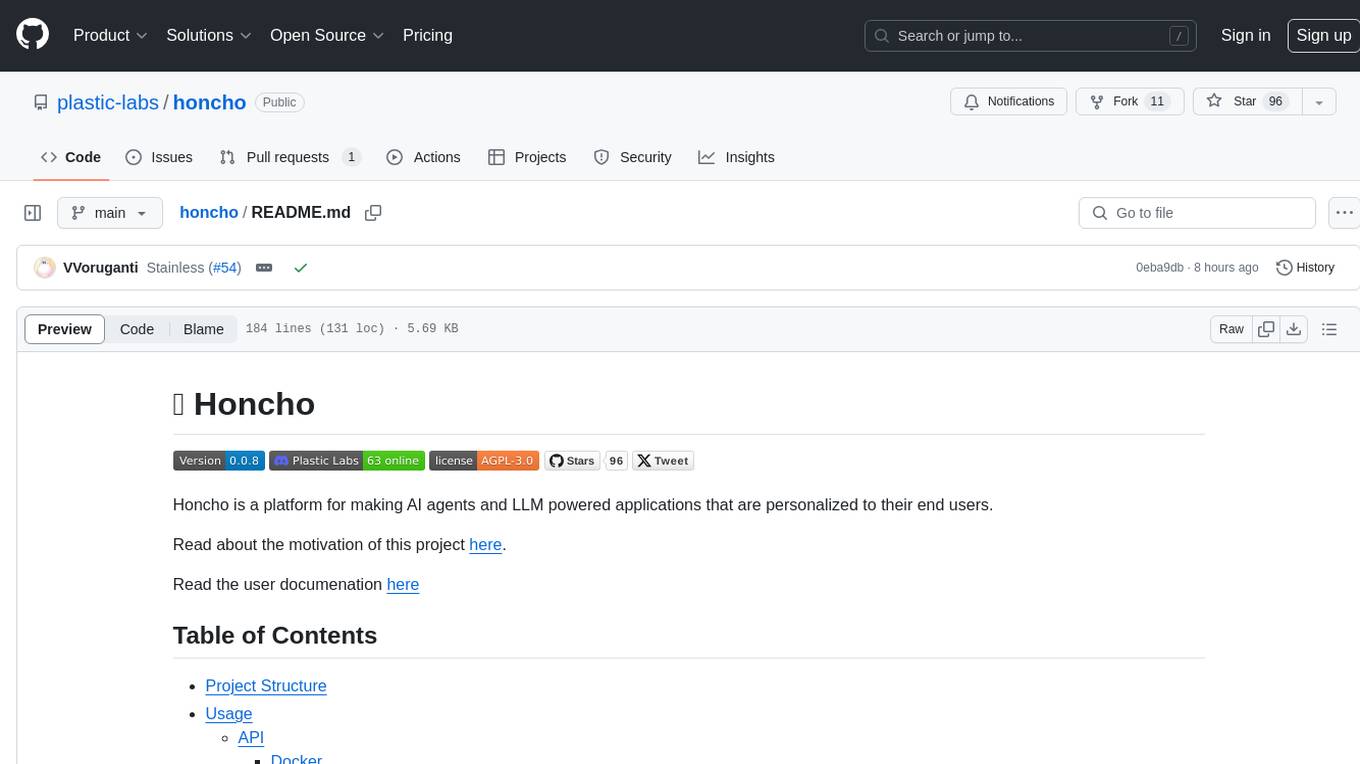
honcho
Honcho is a platform for creating personalized AI agents and LLM powered applications for end users. The repository is a monorepo containing the server/API for managing database interactions and storing application state, along with a Python SDK. It utilizes FastAPI for user context management and Poetry for dependency management. The API can be run using Docker or manually by setting environment variables. The client SDK can be installed using pip or Poetry. The project is open source and welcomes contributions, following a fork and PR workflow. Honcho is licensed under the AGPL-3.0 License.
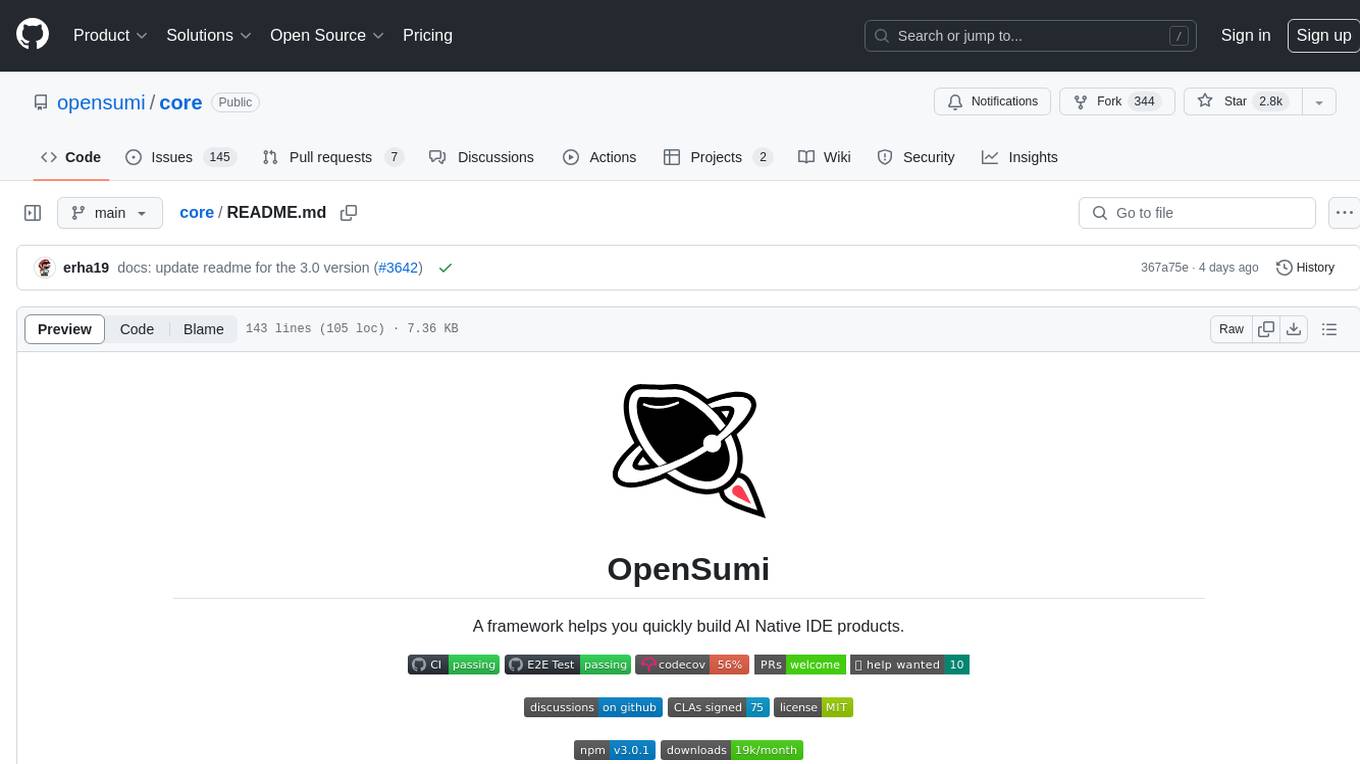
core
OpenSumi is a framework designed to help users quickly build AI Native IDE products. It provides a set of tools and templates for creating Cloud IDEs, Desktop IDEs based on Electron, CodeBlitz web IDE Framework, Lite Web IDE on the Browser, and Mini-App liked IDE. The framework also offers documentation for users to refer to and a detailed guide on contributing to the project. OpenSumi encourages contributions from the community and provides a platform for users to report bugs, contribute code, or improve documentation. The project is licensed under the MIT license and contains third-party code under other open source licenses.
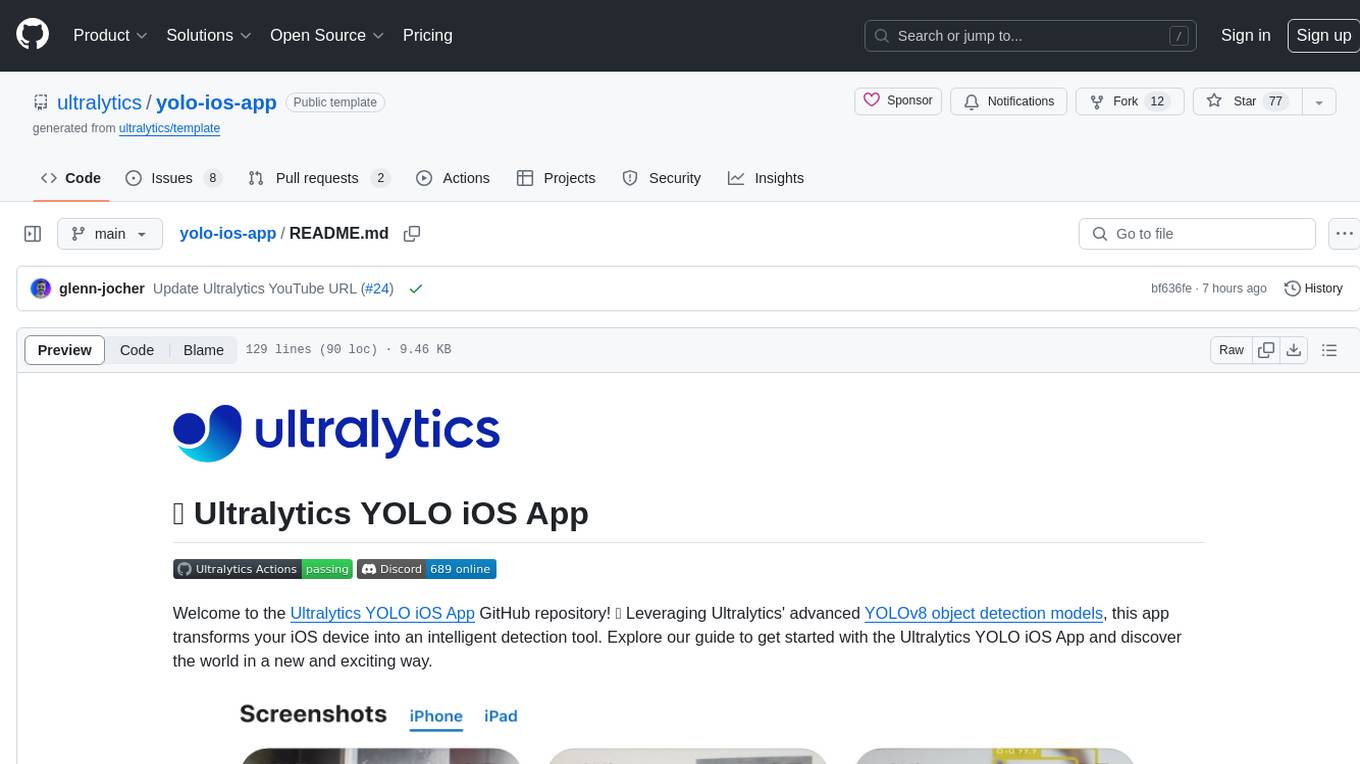
yolo-ios-app
The Ultralytics YOLO iOS App GitHub repository offers an advanced object detection tool leveraging YOLOv8 models for iOS devices. Users can transform their devices into intelligent detection tools to explore the world in a new and exciting way. The app provides real-time detection capabilities with multiple AI models to choose from, ranging from 'nano' to 'x-large'. Contributors are welcome to participate in this open-source project, and licensing options include AGPL-3.0 for open-source use and an Enterprise License for commercial integration. Users can easily set up the app by following the provided steps, including cloning the repository, adding YOLOv8 models, and running the app on their iOS devices.
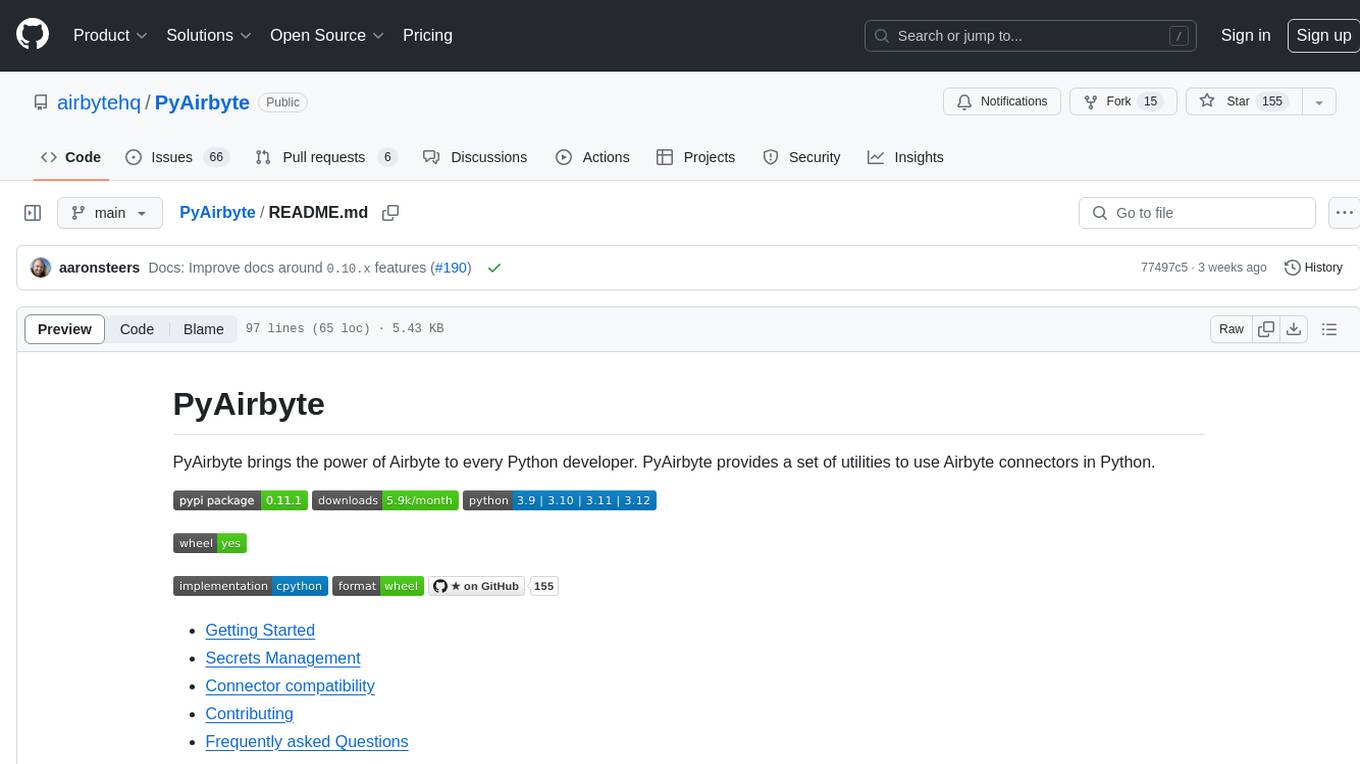
PyAirbyte
PyAirbyte brings the power of Airbyte to every Python developer by providing a set of utilities to use Airbyte connectors in Python. It enables users to easily manage secrets, work with various connectors like GitHub, Shopify, and Postgres, and contribute to the project. PyAirbyte is not a replacement for Airbyte but complements it, supporting data orchestration frameworks like Airflow and Snowpark. Users can develop ETL pipelines and import connectors from local directories. The tool simplifies data integration tasks for Python developers.

md-agent
MD-Agent is a LLM-agent based toolset for Molecular Dynamics. It uses Langchain and a collection of tools to set up and execute molecular dynamics simulations, particularly in OpenMM. The tool assists in environment setup, installation, and usage by providing detailed steps. It also requires API keys for certain functionalities, such as OpenAI and paper-qa for literature searches. Contributions to the project are welcome, with a detailed Contributor's Guide available for interested individuals.
For similar jobs
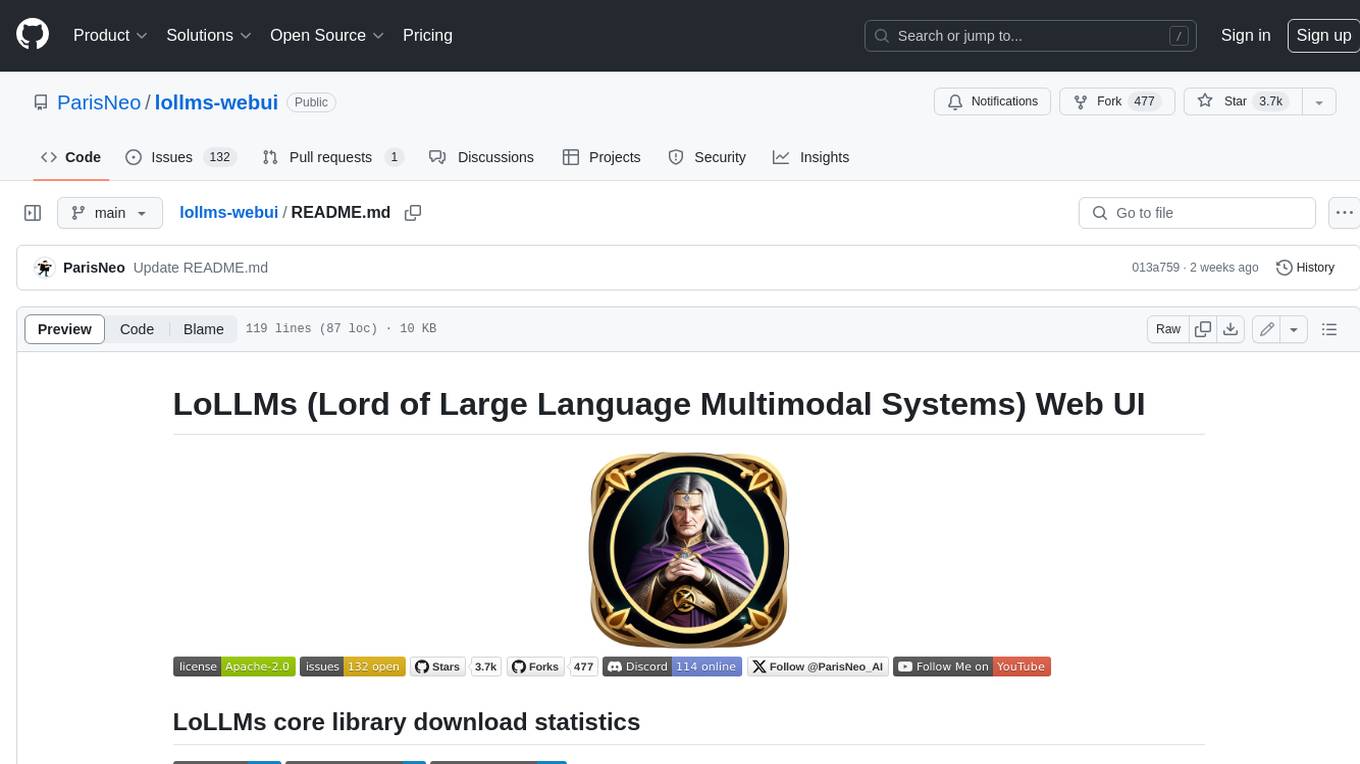
lollms-webui
LoLLMs WebUI (Lord of Large Language Multimodal Systems: One tool to rule them all) is a user-friendly interface to access and utilize various LLM (Large Language Models) and other AI models for a wide range of tasks. With over 500 AI expert conditionings across diverse domains and more than 2500 fine tuned models over multiple domains, LoLLMs WebUI provides an immediate resource for any problem, from car repair to coding assistance, legal matters, medical diagnosis, entertainment, and more. The easy-to-use UI with light and dark mode options, integration with GitHub repository, support for different personalities, and features like thumb up/down rating, copy, edit, and remove messages, local database storage, search, export, and delete multiple discussions, make LoLLMs WebUI a powerful and versatile tool.
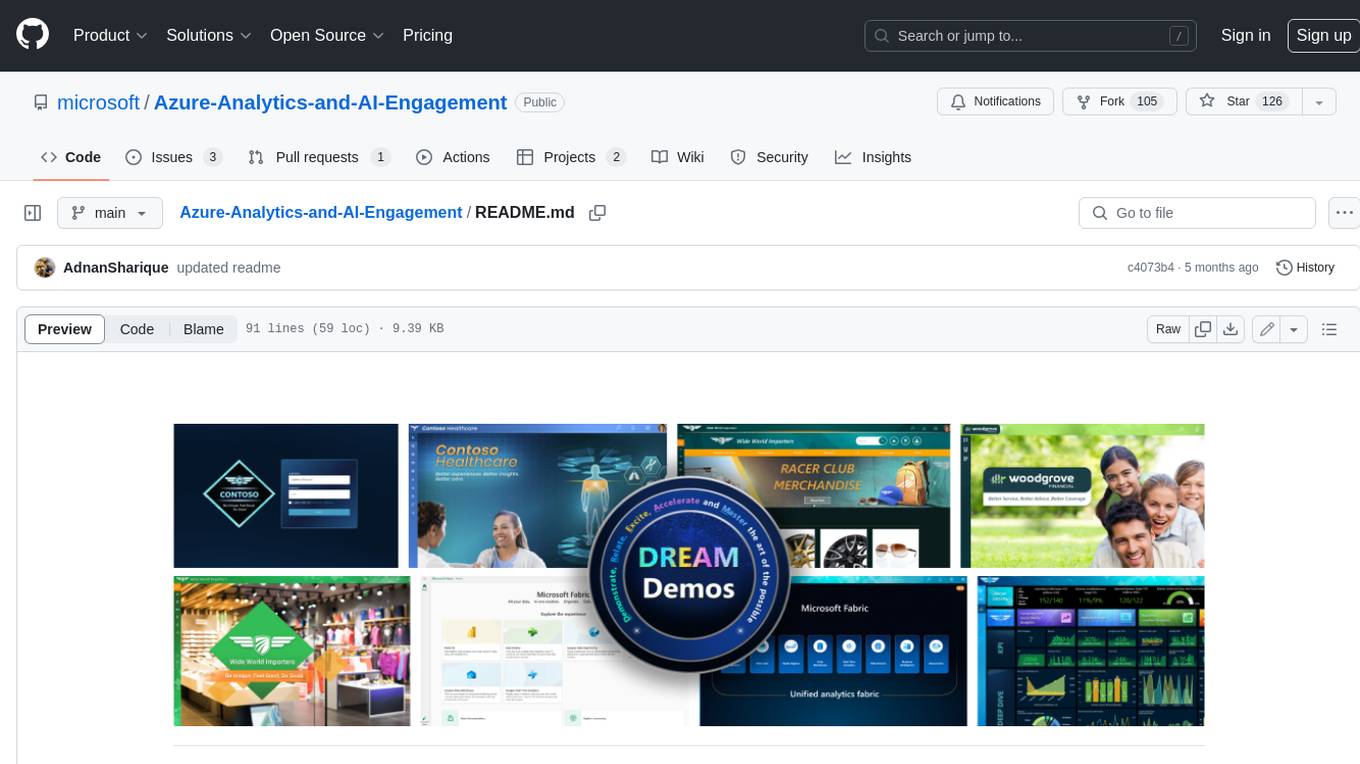
Azure-Analytics-and-AI-Engagement
The Azure-Analytics-and-AI-Engagement repository provides packaged Industry Scenario DREAM Demos with ARM templates (Containing a demo web application, Power BI reports, Synapse resources, AML Notebooks etc.) that can be deployed in a customer’s subscription using the CAPE tool within a matter of few hours. Partners can also deploy DREAM Demos in their own subscriptions using DPoC.
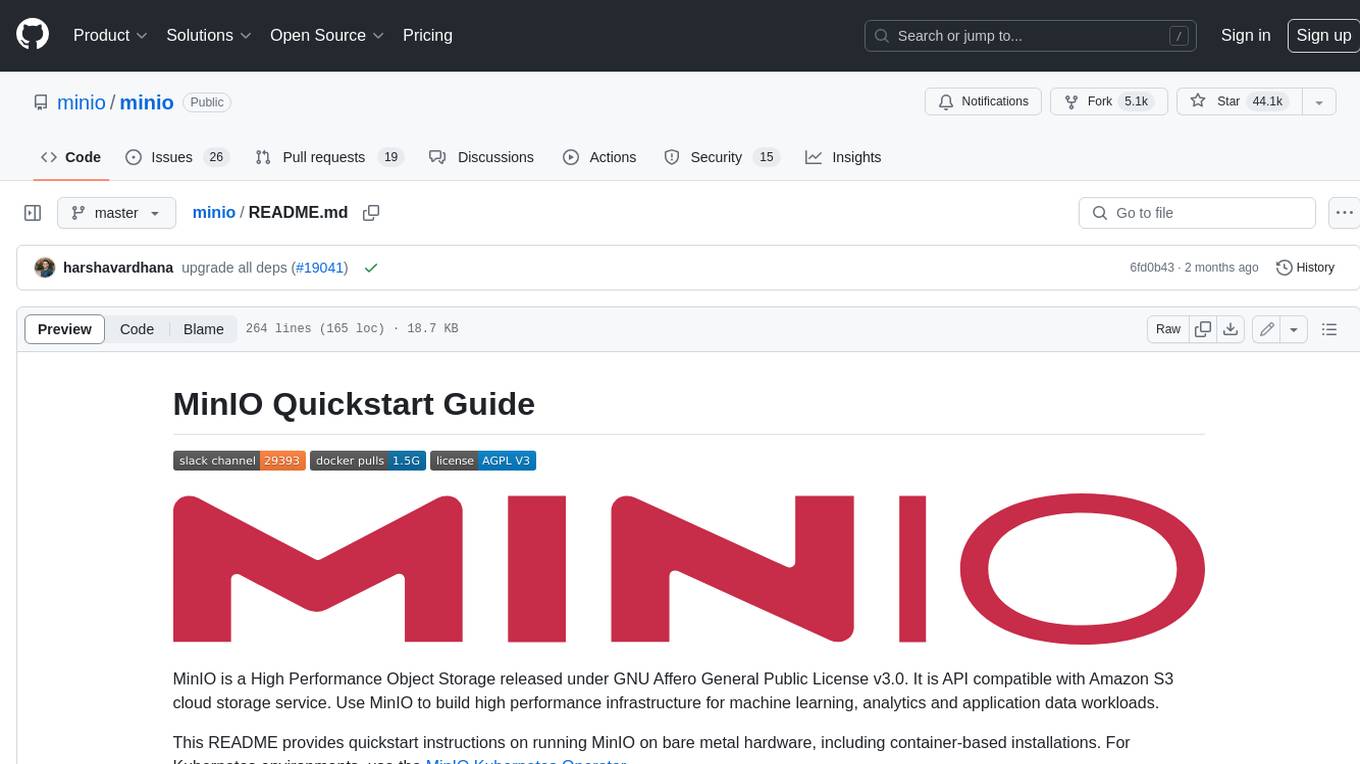
minio
MinIO is a High Performance Object Storage released under GNU Affero General Public License v3.0. It is API compatible with Amazon S3 cloud storage service. Use MinIO to build high performance infrastructure for machine learning, analytics and application data workloads.

mage-ai
Mage is an open-source data pipeline tool for transforming and integrating data. It offers an easy developer experience, engineering best practices built-in, and data as a first-class citizen. Mage makes it easy to build, preview, and launch data pipelines, and provides observability and scaling capabilities. It supports data integrations, streaming pipelines, and dbt integration.
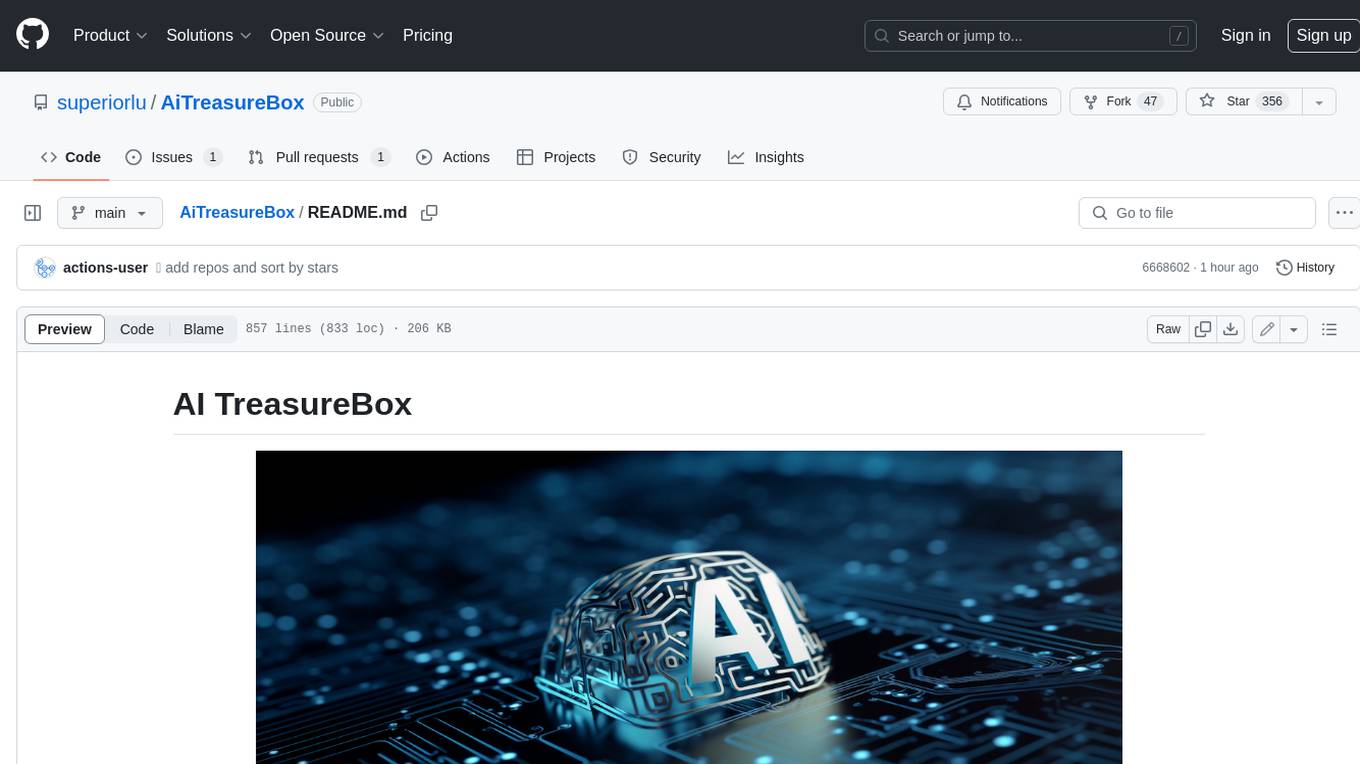
AiTreasureBox
AiTreasureBox is a versatile AI tool that provides a collection of pre-trained models and algorithms for various machine learning tasks. It simplifies the process of implementing AI solutions by offering ready-to-use components that can be easily integrated into projects. With AiTreasureBox, users can quickly prototype and deploy AI applications without the need for extensive knowledge in machine learning or deep learning. The tool covers a wide range of tasks such as image classification, text generation, sentiment analysis, object detection, and more. It is designed to be user-friendly and accessible to both beginners and experienced developers, making AI development more efficient and accessible to a wider audience.
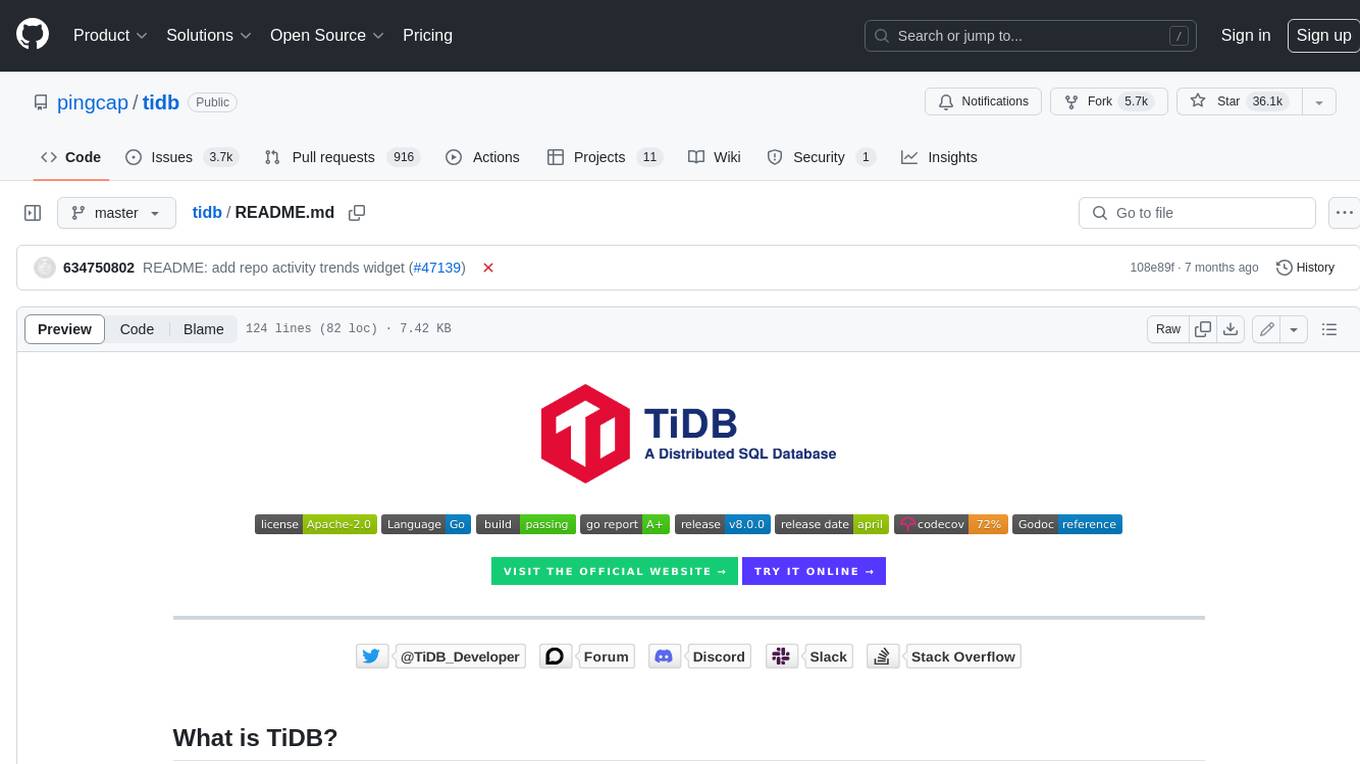
tidb
TiDB is an open-source distributed SQL database that supports Hybrid Transactional and Analytical Processing (HTAP) workloads. It is MySQL compatible and features horizontal scalability, strong consistency, and high availability.
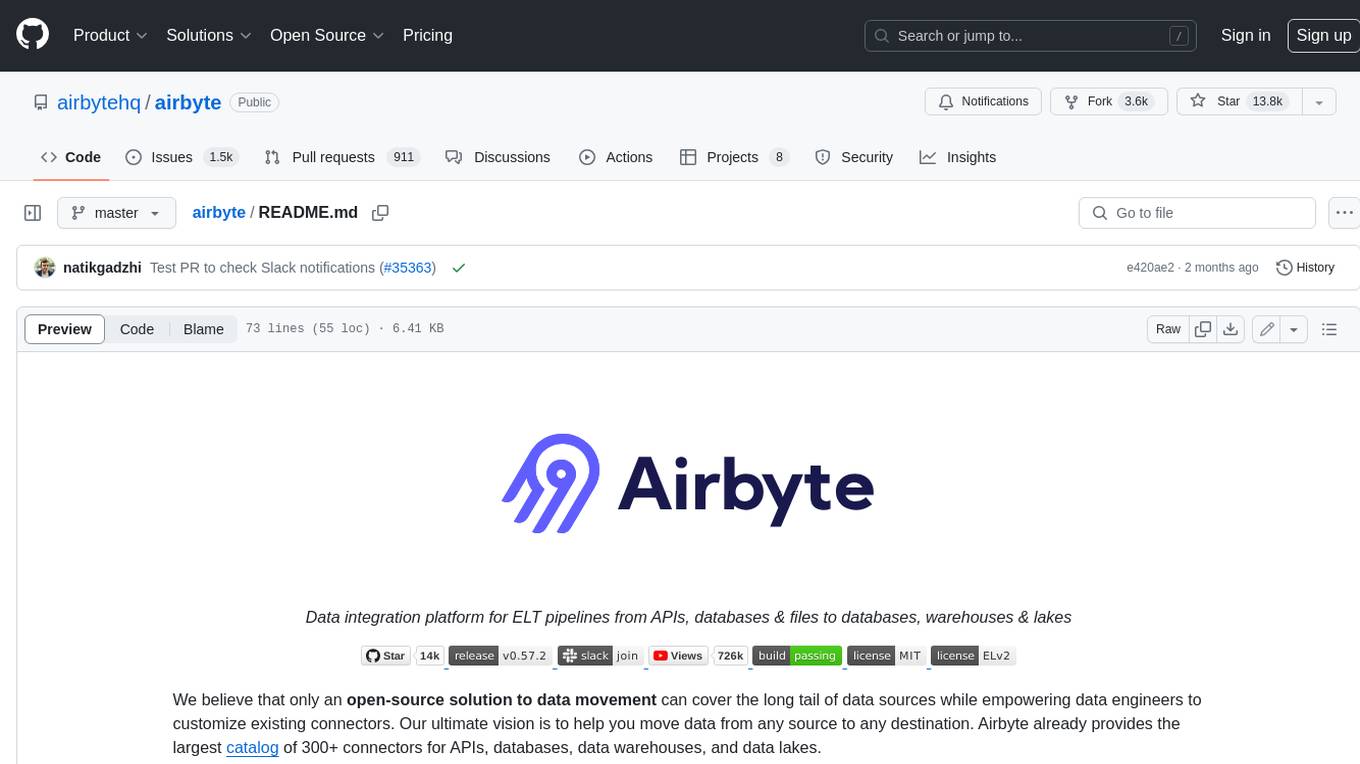
airbyte
Airbyte is an open-source data integration platform that makes it easy to move data from any source to any destination. With Airbyte, you can build and manage data pipelines without writing any code. Airbyte provides a library of pre-built connectors that make it easy to connect to popular data sources and destinations. You can also create your own connectors using Airbyte's no-code Connector Builder or low-code CDK. Airbyte is used by data engineers and analysts at companies of all sizes to build and manage their data pipelines.
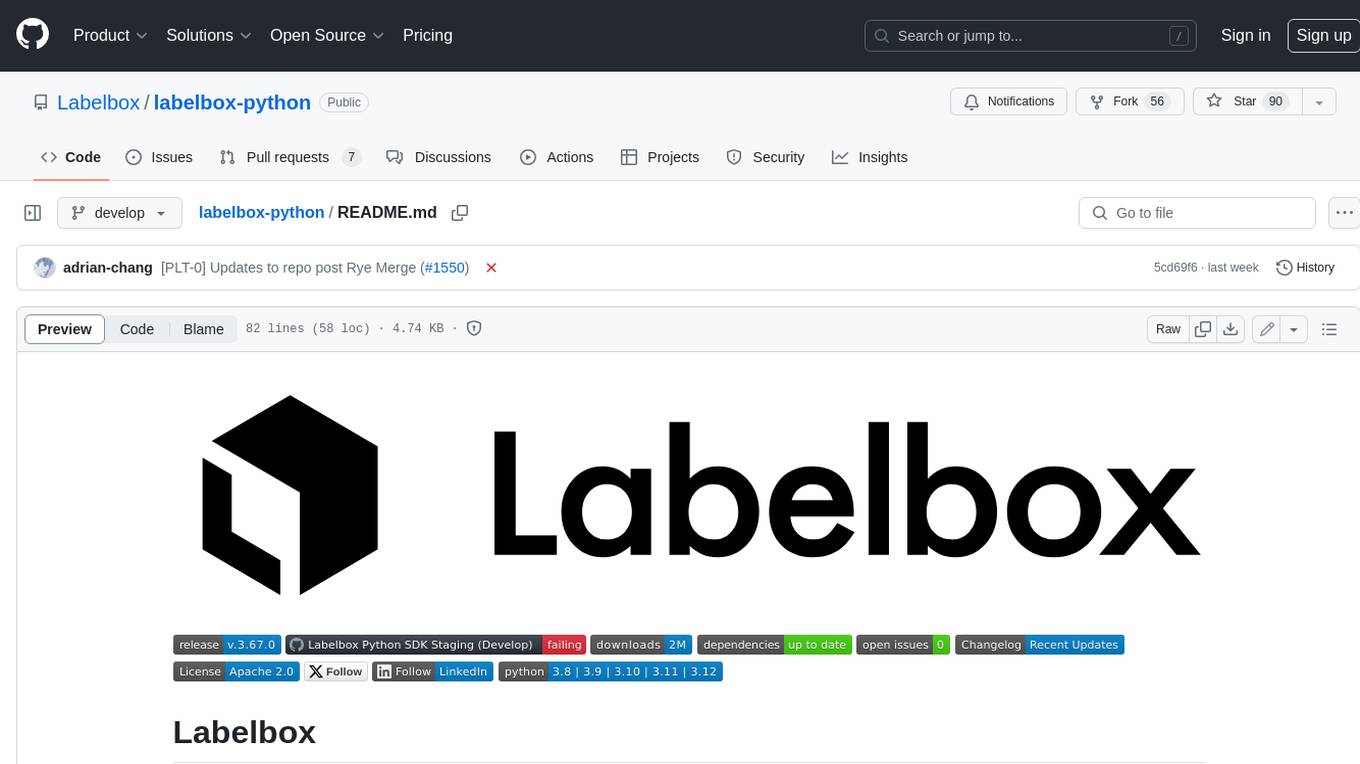
labelbox-python
Labelbox is a data-centric AI platform for enterprises to develop, optimize, and use AI to solve problems and power new products and services. Enterprises use Labelbox to curate data, generate high-quality human feedback data for computer vision and LLMs, evaluate model performance, and automate tasks by combining AI and human-centric workflows. The academic & research community uses Labelbox for cutting-edge AI research.